Affiliate links on Android Authority may earn us a commission. Learn more.
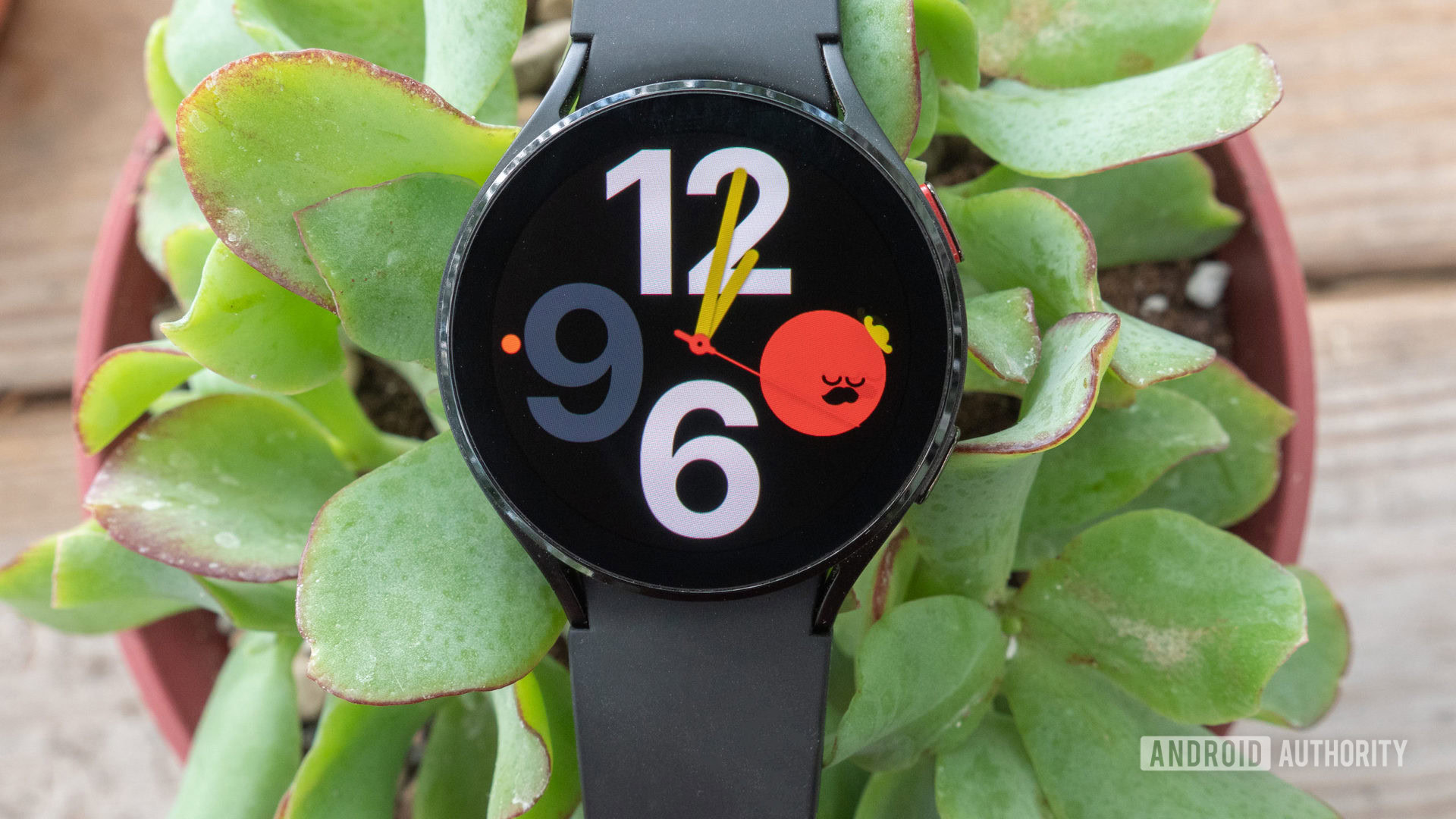

Samsung Galaxy Watch 4 review: A watch with lasting value
Published onApril 5, 2023

Samsung Galaxy Watch 4
MSRP:
What we like
What we don't like

Samsung Galaxy Watch 4
The Samsung Galaxy Watch 4 was an important device for both Samsung and Google at launch. Not only did Samsung ditch its tried-and-true smartwatch platform, but it’s also relied on Google to not drop the ball on Wear OS (again). Google, meanwhile, relied on Samsung to show off what the new Wear OS could do, without having much of a say on the user-facing platform or hardware on which it’s presented. With the launch of the Galaxy Watch 5 series, both companies have since set their eyes on the newest generation. However, the Galaxy Watch 4 still offers a lot for most buyers — as long as those buyers are really into Samsung products. Learn more in our full Samsung Galaxy Watch 4 review.
Update, April 2023: We have updated our Samsung Galaxy Watch 4 review with details on software updates, the latest competition, and more.
What you need to know about the Samsung Galaxy Watch 4
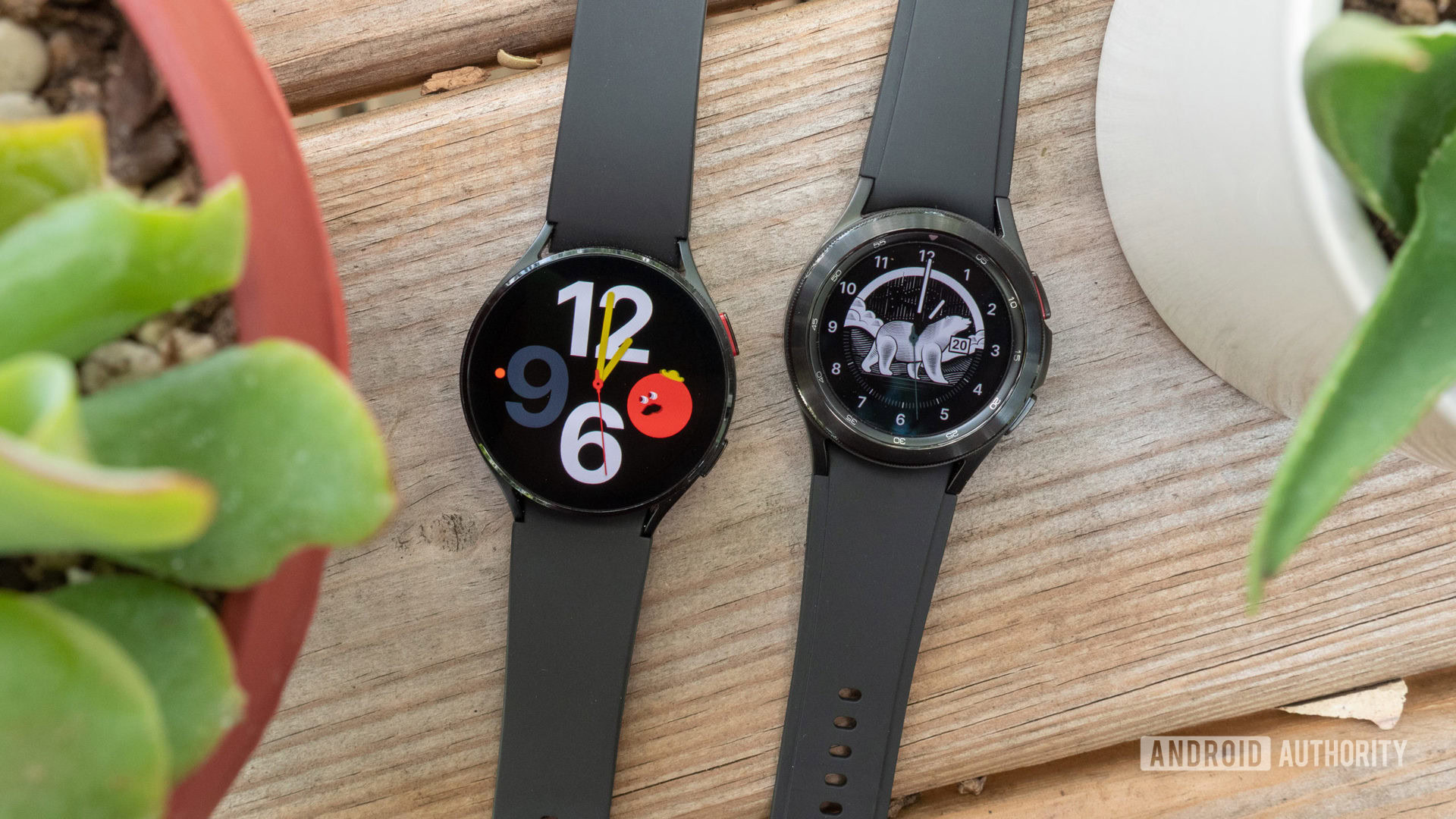
- Samsung Galaxy Watch 4 (40mm Bluetooth-only): $249 / €369 / £369
- Samsung Galaxy Watch 4 (44mm Bluetooth-only): $279
- Samsung Galaxy Watch 4 (40mm LTE): $299
- Samsung Galaxy Watch 4 (44mm LTE): $329
- Samsung Galaxy Watch 4 Classic (42mm Bluetooth-only): $349 / €269 / £259
- Samsung Galaxy Watch 4 Classic (46mm Bluetooth-only): $379
- Samsung Galaxy Watch 4 Classic (42mm LTE): $399
- Samsung Galaxy Watch 4 Classic (46mm LTE): $429
The Galaxy Watch 4 is Samsung’s 2021 flagship smartwatch. It’s different from preceding Samsung smartwatches in that it’s running a newer version of Google’s smartwatch platform, Wear OS, which was co-developed by both companies.
The Samsung Galaxy Watch 4 comes in two flavors: the Galaxy Watch 4, which is the sportier version and the direct follow-up to 2019’s Galaxy Watch Active 2; and the Galaxy Watch 4 Classic, which is made with higher-end materials and is the follow-up to 2020’s Galaxy Watch 3. Both the Watch 4 and Watch 4 Classic are offered in small and large sizes and have optional LTE-connected variants.
Regardless of which variant you buy, you’ll get the same feature set and mostly the same internal hardware. These are meant to be everything-but-the-kitchen-sink smartwatches, so they offer plenty of smart features as well as fitness- and health-tracking modes. They can pair with most Android phones, but the best experience will be had with a paired Samsung phone (more on that later).
You’ll find better color options with the standard Galaxy Watch 4, which is offered in Black, Silver, Green, and Pink Gold. The Galaxy Watch Classic is only offered in Black and Silver options.
Samsung is approaching Galaxy Watch 4 availability like it does its smartphones: there’s really a Galaxy Watch 4 model for everybody. Pricing starts at $249 for the smallest Bluetooth-only Galaxy Watch 4 and $279 for the larger Bluetooth model. Each Galaxy Watch 4 Classic model generally costs $100 more than its sportier counterpart. LTE-connected variants are even more expensive and are sold by Verizon and AT&T in the United States.
Since its launch, the Samsung Galaxy Watch 4 has received numerous discounts, more so now that the Galaxy Watch 5 is now available. If you buy at the right time, it’s possible to snag a Galaxy Watch 4 for as little as $200. If you are debating which device to purchase, read our Samsung Galaxy Watch 4 vs Galaxy Watch 5 dedicated guide.
Design: An option for everyone
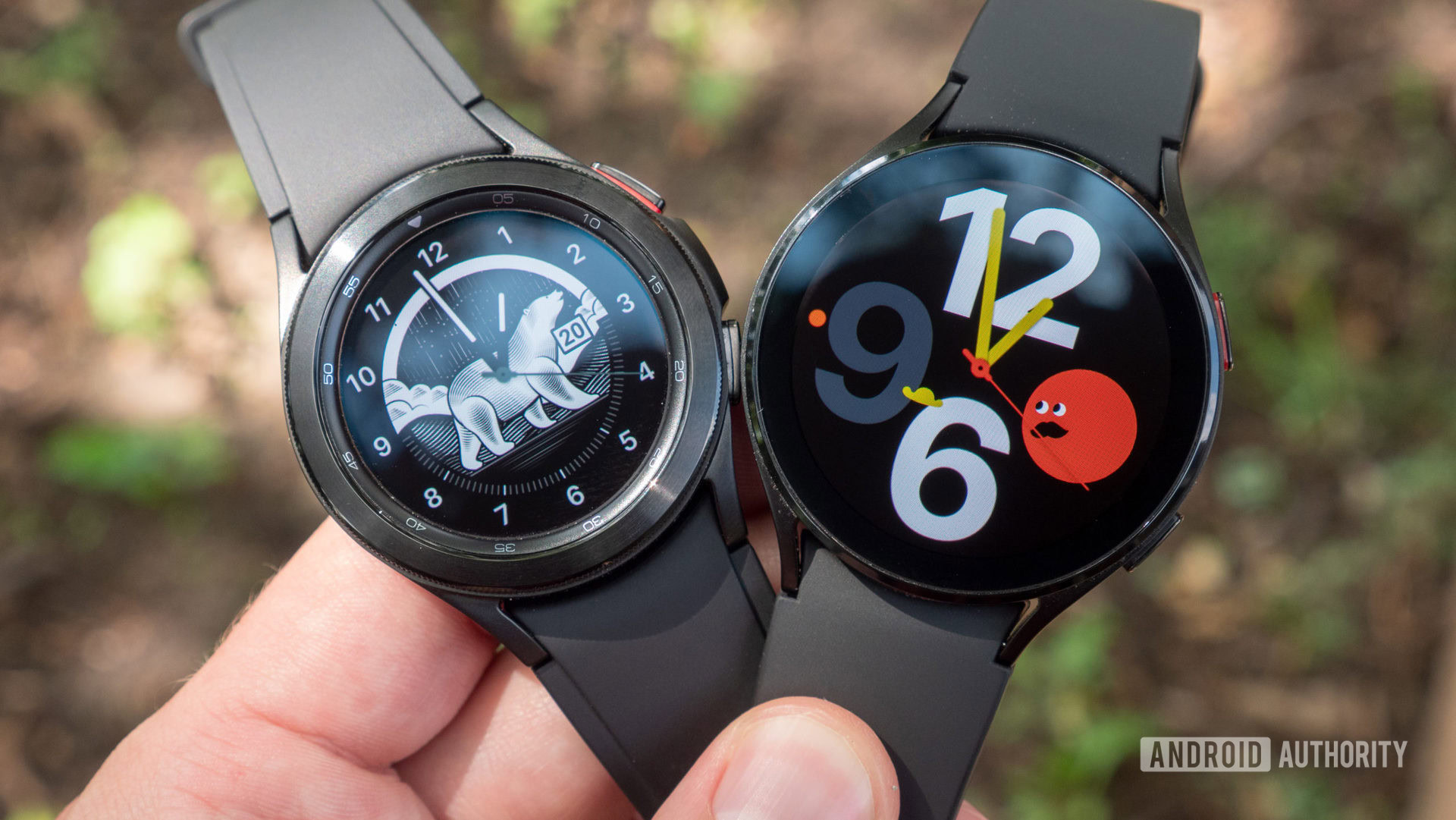
The Samsung Galaxy Watch 4 and Galaxy Watch 4 Classic are made for different people with different needs. The Galaxy Watch 4 is thinner and lighter than the Classic. It’s made of a lighter material, aluminum, and is meant to be the sportier option. It also omits the physical rotating bezel that’s so often associated with the Galaxy Watch line, though it has a touch-enabled bezel that lets you spin your finger around the edge of the device to swipe through software menus. It’s handy, but nowhere near as easy to use as the Classic’s bezel.
The Galaxy Watch 4 Classic has a stainless steel frame and is slightly heavier than the regular Galaxy Watch 4. It matches the Galaxy Watch 4 in fitness tracking features, so there’s no reason why you couldn’t use it as a dedicated fitness watch, but it’s definitely more suited for wear at the office. I’ve found both smartwatches to be comfortable for all-day wear. I prefer the Galaxy Watch 4 over the Classic model; it’s just lighter and easier to wear all day on the wrist. That said, the newest generation omits a physical bezel altogether, so the 4’s Classic is your best pick if that feature is a priority.
The Galaxy Watch 4 and Watch 4 Classic are perfect for all-day wear.
Even so, I don’t expect the Galaxy Watch 4 to comfortably fit everyone’s wrists, at least not with the provided silicone straps. The smartwatches have somewhat of a Fitbit Ionic problem where the angle at which the straps connect to the case protrudes out a bit more than I’d like, leaving some extra space under the case’s lugs. It makes the watches feel bulkier than they need to be. This could be remedied with a different strap that doesn’t have the same angled connectors as the stock silicone straps that ship with the watches.
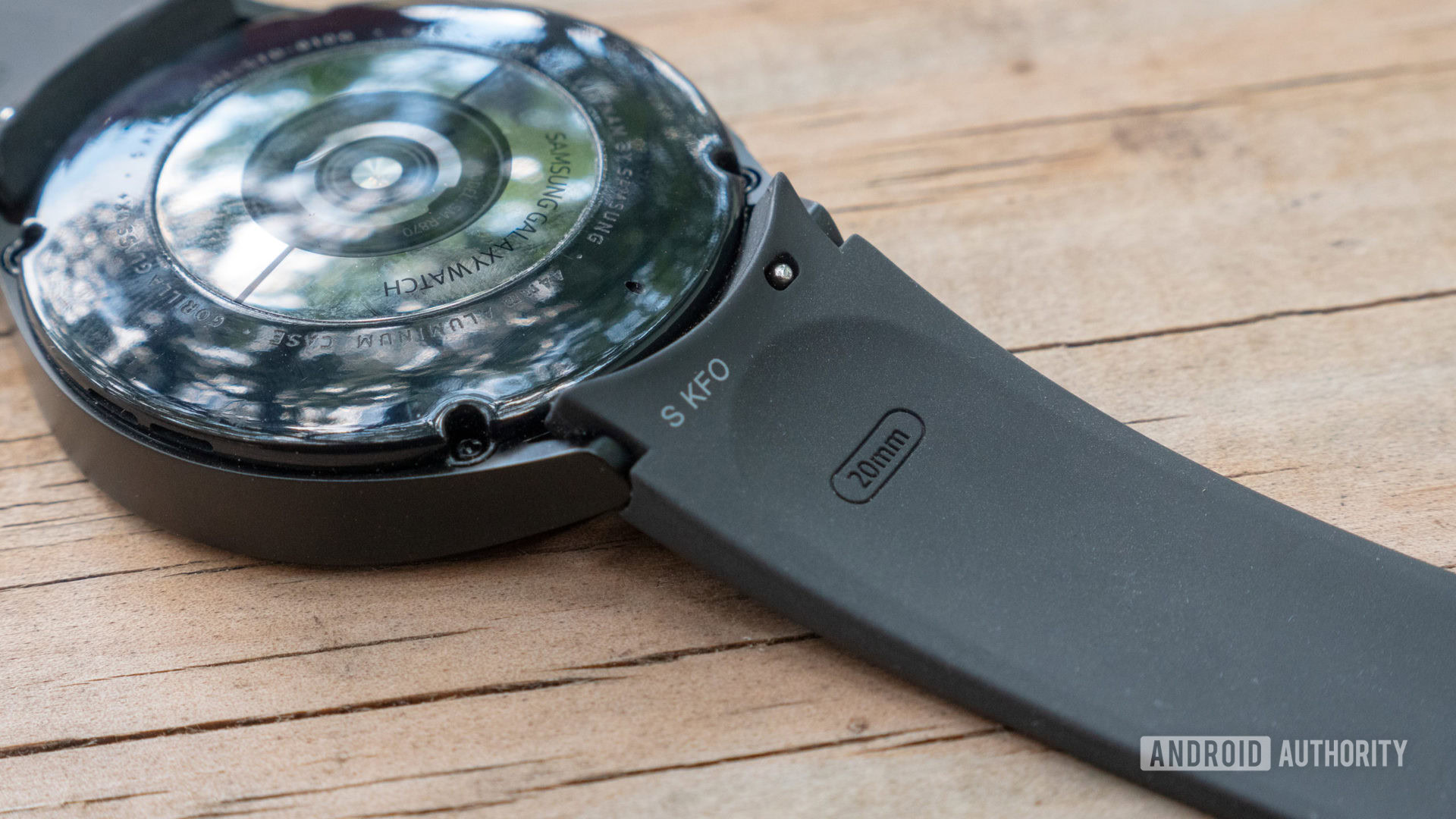
Despite there being multiple case sizes, all Galaxy Watch 4 models are compatible with standard 20mm straps. The silicone straps that ship with both models are soft and comfortable to wear all day, but I’ve had a hell of a time trying to change them. The strap pin sits flush with the strap itself, so digging a fingernail into the strap to remove it has proven challenging, at least for me. You can buy additional leather and silicone straps directly from Samsung. Of course, if you don’t like what you see on Samsung’s website (or you just want to save some money), other retailers have a huge selection of Galaxy Watch 4 replacement straps to choose from.
As mentioned, both models come in small and large sizes. Our Samsung Galaxy Watch 4 review unit is the larger 44mm size and has a 1.36-inch AMOLED screen. There’s also a 40mm Galaxy Watch 4 with a 1.19-inch display. The Galaxy Watch 4 Classic comes in 46mm and 42mm (we have the smaller one), which have the same screen sizes as their similarly sized counterparts.
This should come as no surprise, but the Galaxy Watch 4’s AMOLED panels look fantastic. They get super bright, the colors are punchy, and they offer clear viewing angles. The watches have ambient light sensors so your screen brightness will adjust automatically when you switch from outdoors to indoors. I’ve not had any problems with the screens getting too dim or too bright indoors while I’m lying in bed or outdoors in direct sunlight.
Battery: Good, not great
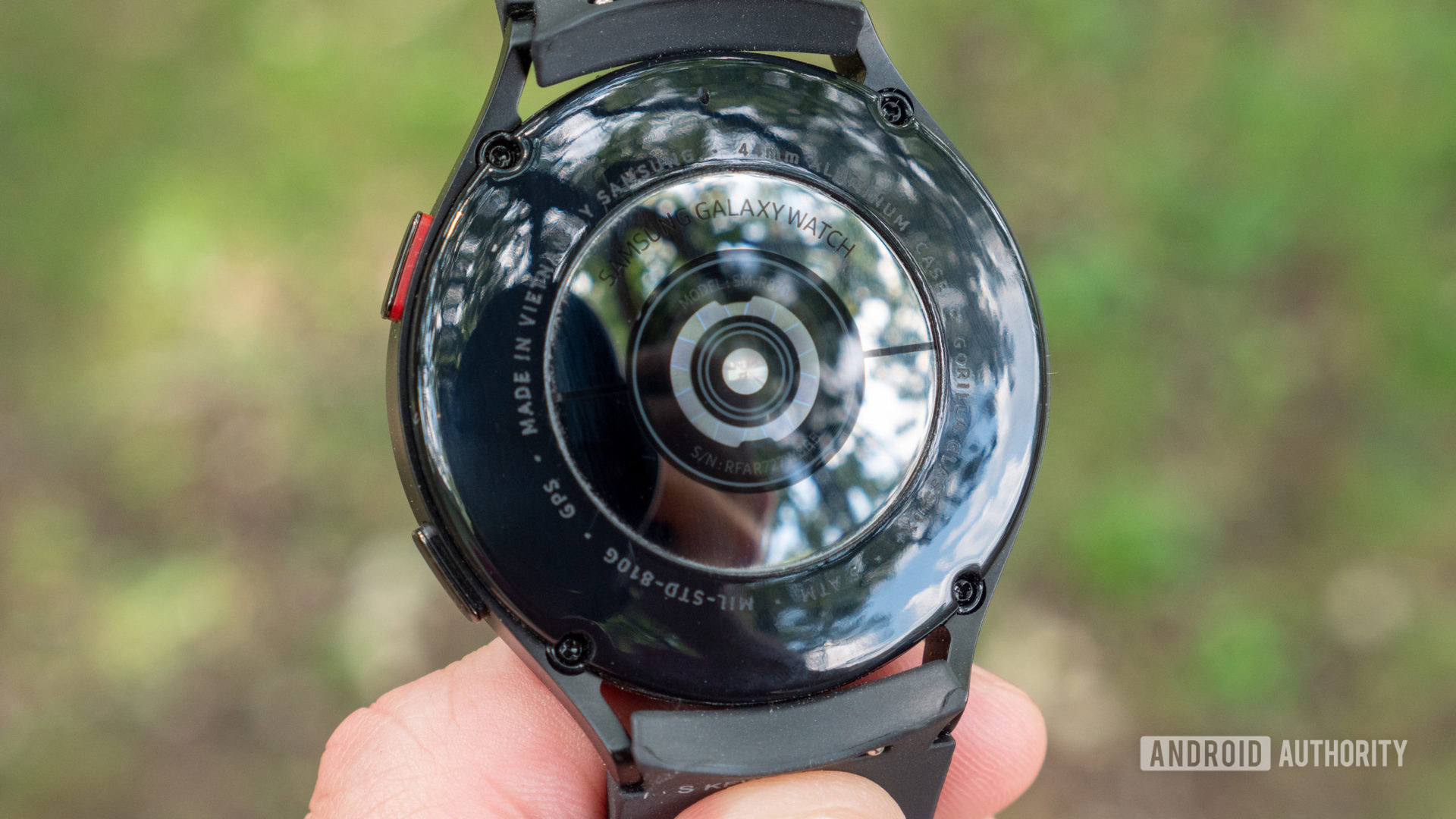
Both bigger-sized watches have a 361mAh battery and the smaller models have 247mAh batteries. Regardless of which model or size you choose, Samsung claims each one should last you around 40 hours on a single charge. That’s definitely not been my experience.
I’ve primarily used the larger Galaxy Watch 4 in my testing and have consistently had the watch last 1.5 days on a single charge. After nearly a day and a half of usage, my watch hit 15% battery after having the always-on display turned on, tilt-to-wake off, auto-brightness on, heart rate and stress recording turned on, Wi-Fi, NFC, and location on, and one night of sleep tracking with SpO2 measurements. I also ran five miles outdoors with the GPS enabled.
Battery life is good for a Wear OS device, but still not as good as a Fitbit or Garmin smartwatch.
On another day, I went to bed with 40% battery after 24 hours of use with the same settings I used above, just with no workout. Those results are actually pretty good considering I was pushing the watch quite hard. But as is usually the case with smartwatch battery estimates, a company’s “up to X hours” estimates will mean you’ll need to turn some sensors off to get there. Also, any combination of the settings above could widely skew your results — these are small batteries we’re dealing with, after all.
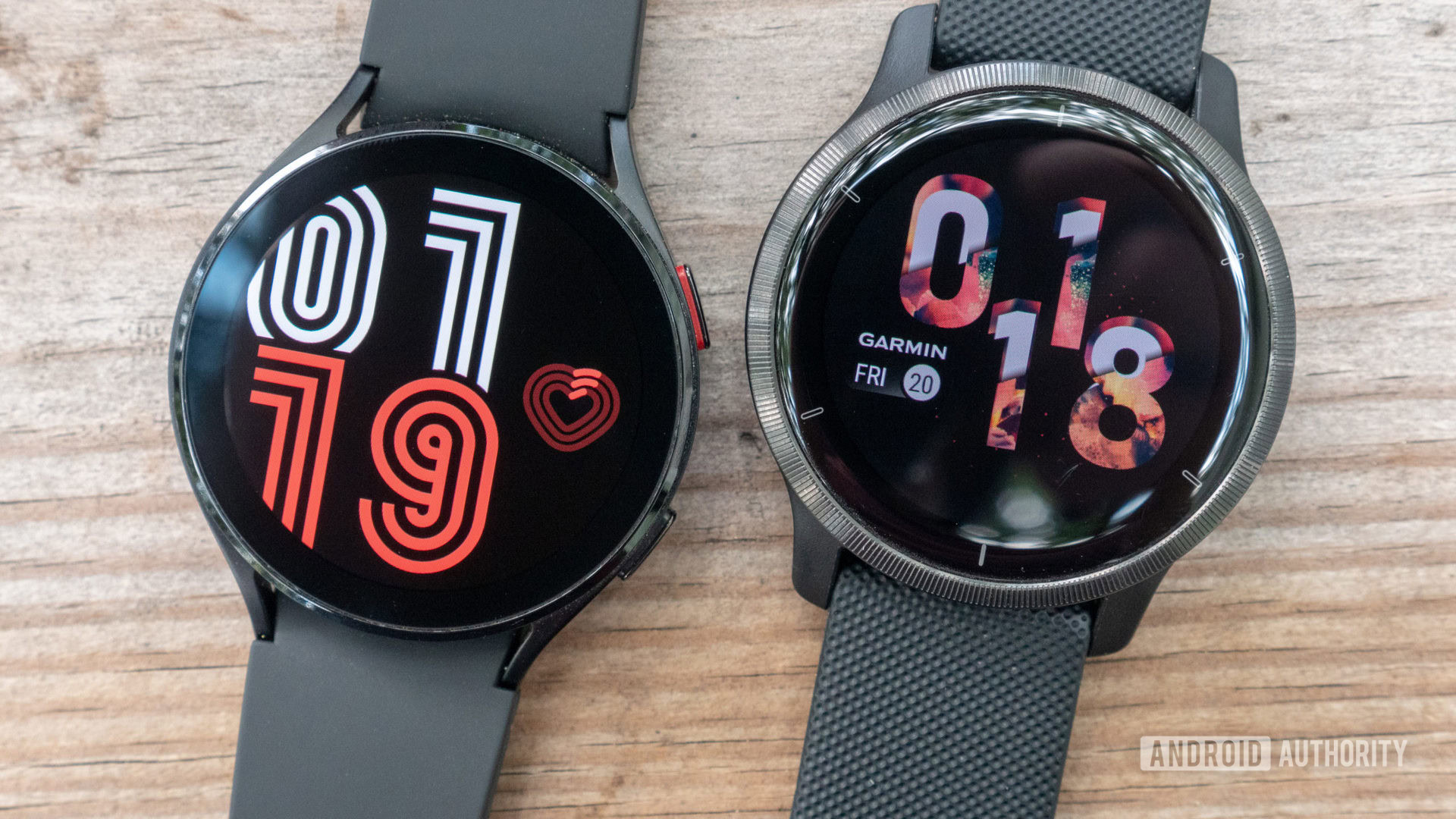
The 40mm Galaxy Watch 4 Classic didn’t last nearly as long as the larger model during testing. I was able to get it to last 24 hours on a charge (with one night of sleep tracking), but that’s it. If you’re after the longest-lasting Galaxy Watch 4, buy one of the bigger ones. Unfortunately, Wear OS’ battery life still isn’t up to compete with other platforms like Fitbit and Garmin, which have been outlasting Google’s watches for years.
One of the bigger headaches I’ve had with both watches is their charging times. Both can receive about 10 hours of usage after only 30 minutes of charging, but a full charge takes nearly two full hours. That’s a long time to sit around and wait to put your smartwatch back on. It’d be a different conversation if they only needed to be charged every week or so, but these are one- to two-day smartwatches.
Health and fitness tracking: Moving in the right direction
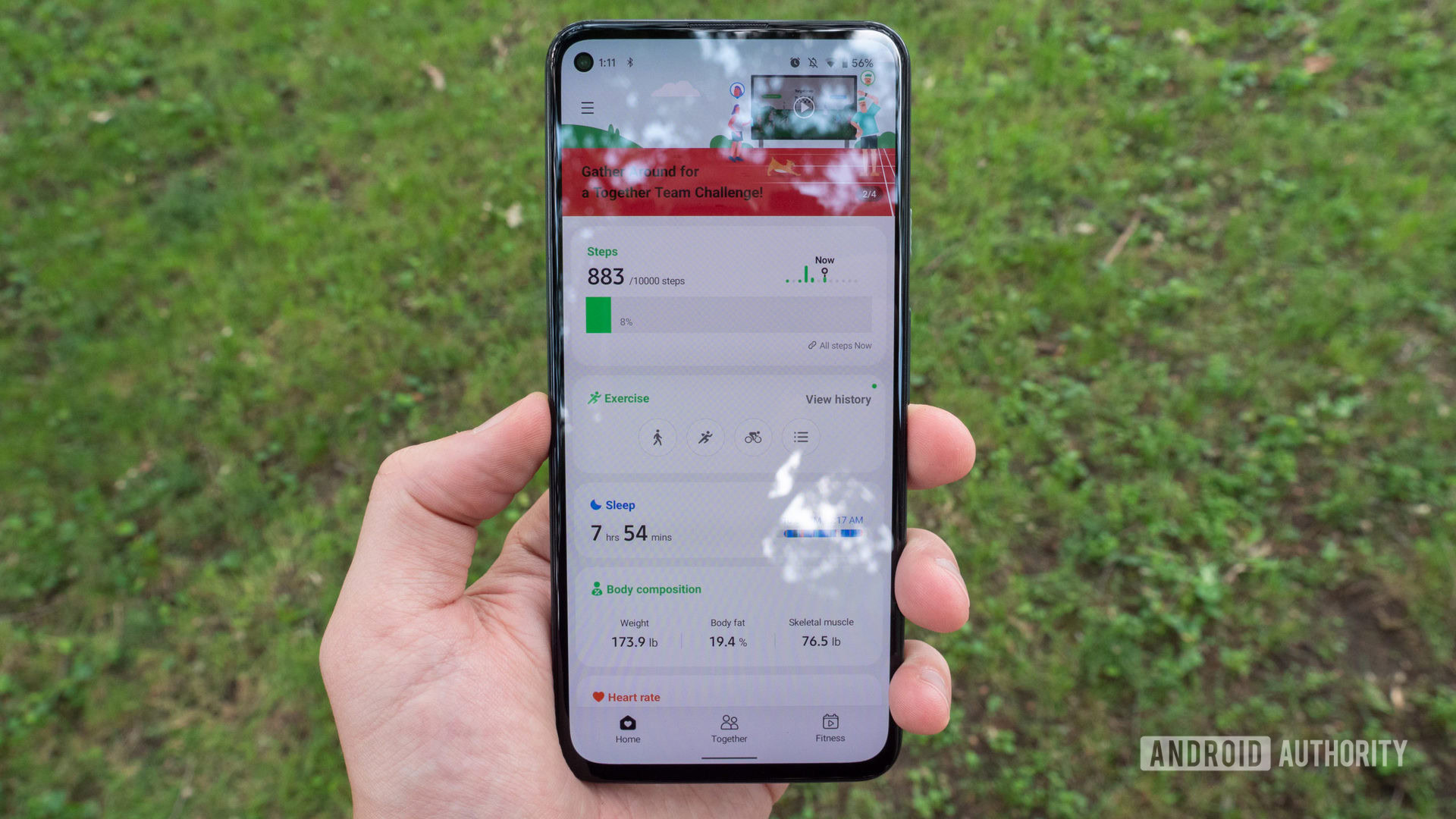
We'll also briefly mention that Samsung's watches can monitor blood pressure readings, but this feature is limited. It's available in just over 50 countries (except the US) and, you guessed it, you need a Samsung phone to make it work.
The Samsung Galaxy Watch 4 series tracks all of the basic health stats you’d expect. It tracks your steps, daily calorie burn, active calories, distance, total active time, sleep, blood oxygen levels (on-demand and during sleep), resting and active heart rate, and stress. Activity stats are tracked through Samsung Health, not Google Fit. There are no Fitbit integrations to be found, as were mentioned during the Wear OS 3 unveiling. For those, you’ll want to take a look at Google’s own Pixel Watch which boasts tons of Fitbit tools and features. For a more detailed comparisong of these two competitors, read our dedicated Galaxy Watch vs Pixel Watch guide.
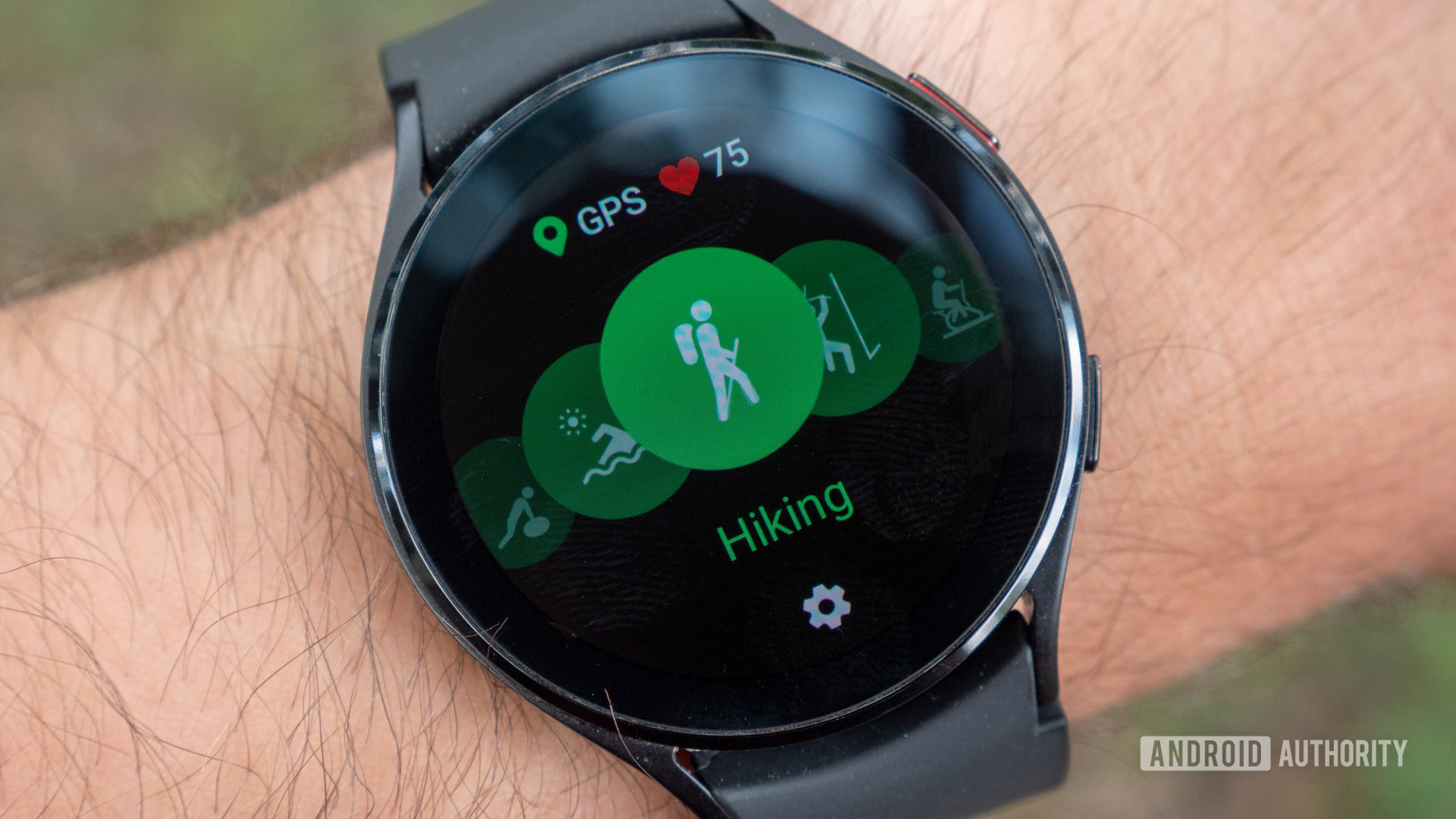
On the Galaxy Watch at least, users can track more than 90 sport modes with the Galaxy Watch 4 series. That includes all the basics, such as running, hiking, cycling, and yoga. There are quite a few weightlifting modes to choose from as well like bench pressing, arm curls, and leg curls. There’s even a snorkeling mode if you’re into that. During GPS-enabled exercises, you’ll get workout data such as pace, elevation, cadence, heart rate zones, splits, and VO2 max. I really like how Samsung Health lays out all of the post-workout data. The pace/elevation charts specifically make it easy to see how all of your data connects.
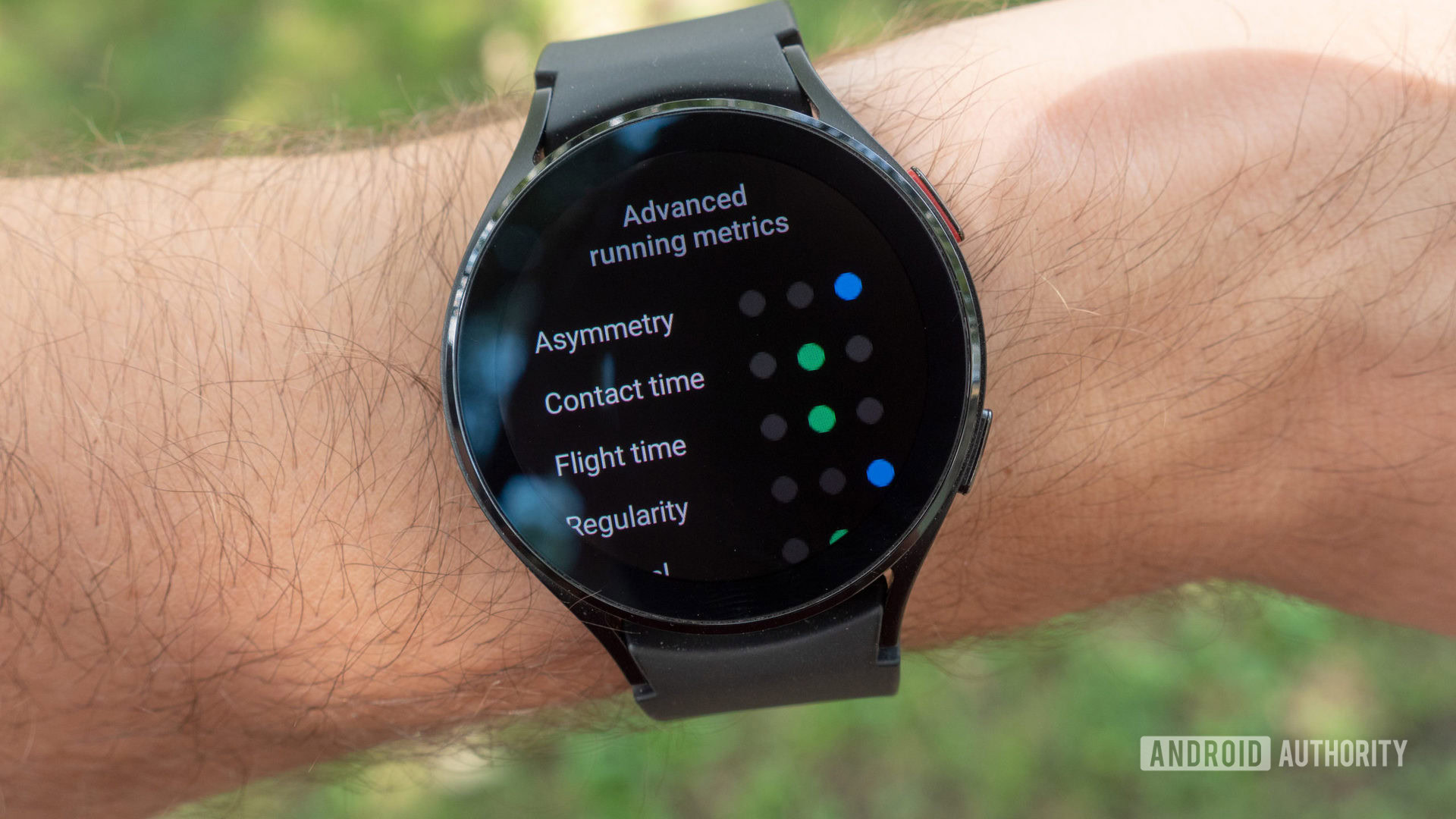
The Samsung Galaxy Watch 4 caters to runners by offering advanced running metrics. I praised these metrics in my Galaxy Watch 3 review, and I’m happy to see them back this year. The Galaxy Watch 4 will track your asymmetry, contact time, flight time, regularity, vertical, and stiffness throughout each of your runs. You’ll get a score for each one (improve, good, or great), which can be helpful when you’re trying to nail down your running form. I find it fascinating to dig through this data. The stiffness metric, for instance, showed that I was stiffer during the first 35 minutes of my run, which was absolutely the case for one particular workout.
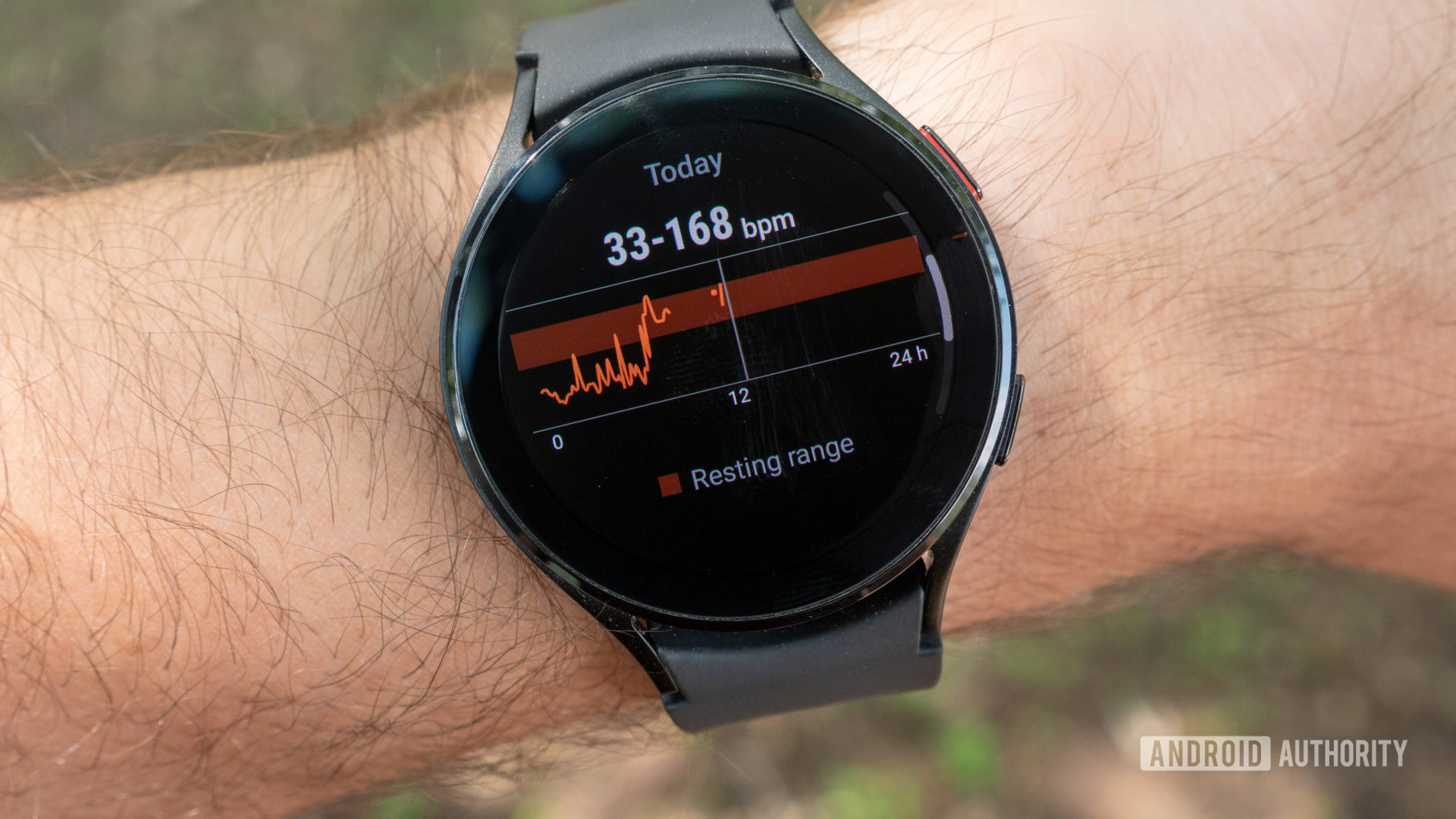
The Samsung Galaxy Watch 4 series has what Samsung is calling a BioActive sensor, which includes its optical heart rate sensor (PPG), electrocardiogram (ECG), and bioelectrical impedance (BIA) sensor. Let’s talk heart rate first. I admit I was concerned when Samsung told me it was using the same heart rate sensor module that appeared in the Galaxy Watch 3 and Active 2. Both of those watches compared extremely poorly to other wearables and chest straps in terms of heart rate accuracy.

But the Galaxy Watch 4 series has new algorithms to make up for those issues. In my testing, I’ve actually come away impressed with the Galaxy Watch 4’s accuracy. The heart rate graph above illustrates a hot-and-sweaty run compared to the Apple Watch Series 6 and Polar H10 chest strap. The Galaxy Watch 4 kept up nicely with the Polar H10 and Apple Watch throughout nearly the entire run. This was a challenging run overall because it included hills, sprints, and two major stopping points where I rested for a few moments. Even at the highest peaks and lowest valleys, the Watch 4 reported accurate numbers.

Above is a closer look at the middle section of the run, containing both rests with a major heart rate increase in between. Here’s where you can start to see a difference between the three devices, though. Samsung’s watch only reports heart rate readings every 30 seconds, hence the lack of minute data points in the stark ups and downs (see 27:00-35:00). It recorded the gist of what was happening with my heart, but lots of details were left out due to the sensor’s recording limitations. 30-second recordings should be fine enough for most people. And let’s be honest, this should have been the least of Samsung’s worries when updating its sensor algorithms. But “good enough” is better than I imagined, so I’m considering that a win for Samsung’s heart rate sensor.
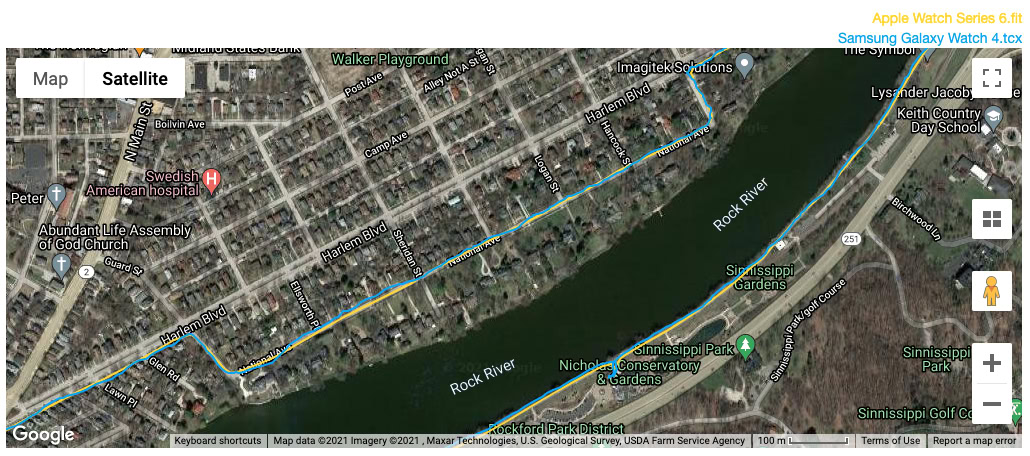
GPS accuracy is, unfortunately, another story. I’m willing to give Samsung the benefit of the doubt with the run above as it was partly cloudy and I wasn’t necessarily avoiding troublesome spots like bridges or heavy tree coverage. Still, let’s see how it compares to the Apple Watch Series 6 on a stretch of road with heavy tree coverage: The Apple Watch stuck to the road with no issues. The Galaxy Watch 4 did most of the time as well, though it veered off into houses and yards a bit more than I would have liked.
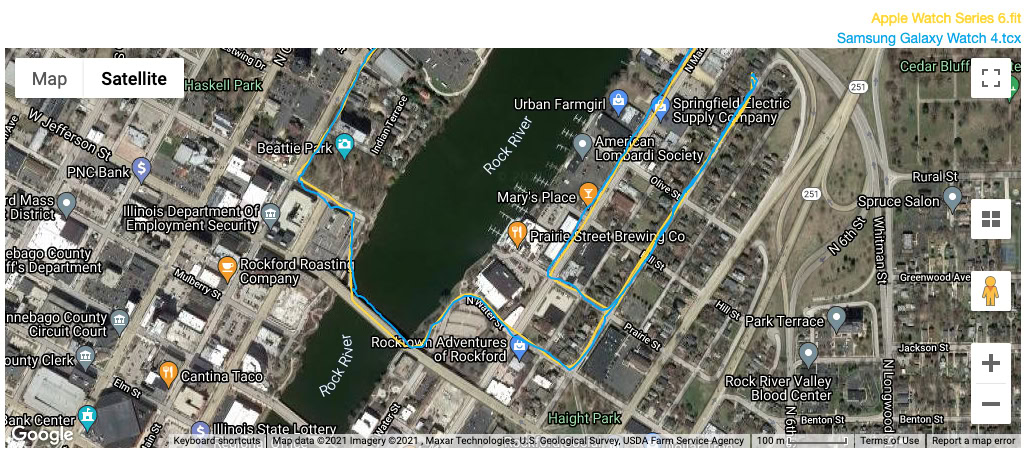
During another part of the run (above), I took the two watches across the Rock River under a bridge followed by a quick two-block sprint around some buildings. Again, the Apple Watch is the standout device here, while the Galaxy Watch 4… is not. Again, this was a challenging route for any GPS tracker to take on, and results like these are, unfortunately, par for the course for many wearables. Still, I’d call it an improvement over what we had with the Galaxy Watch 3 and Active 2.
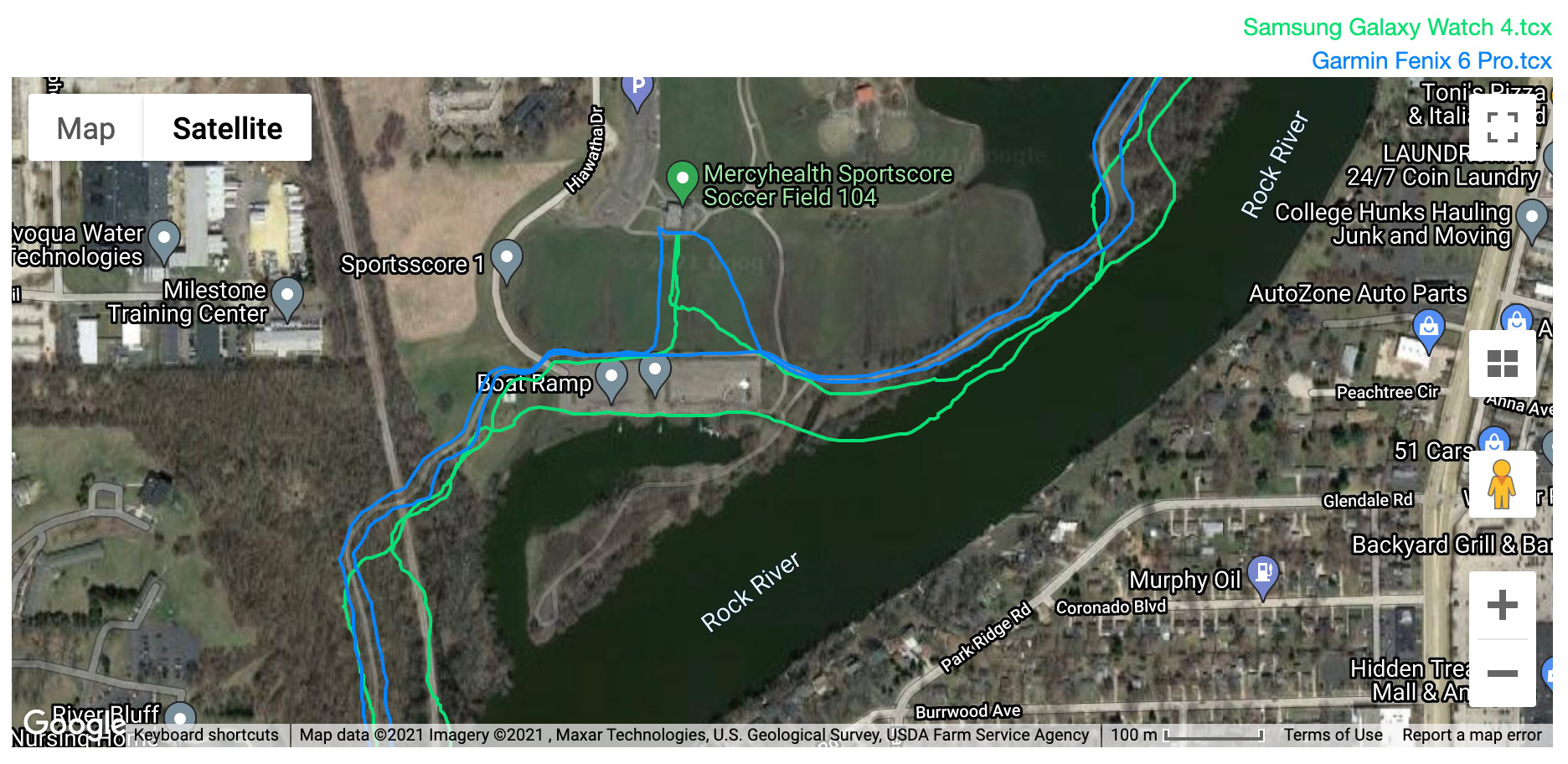
But then, on a completely sunny day, the Galaxy Watch 4 borked my 15-mile run in a few areas. See above for a comparison between the Garmin Fenix 6 Pro and Galaxy Watch. Not only did the Samsung watch put me in the river for a good half-mile, it almost completely missed my veer off into a soccer field to grab a refill from the water fountain (see the green line under “Mercyhealth Sportscore”).
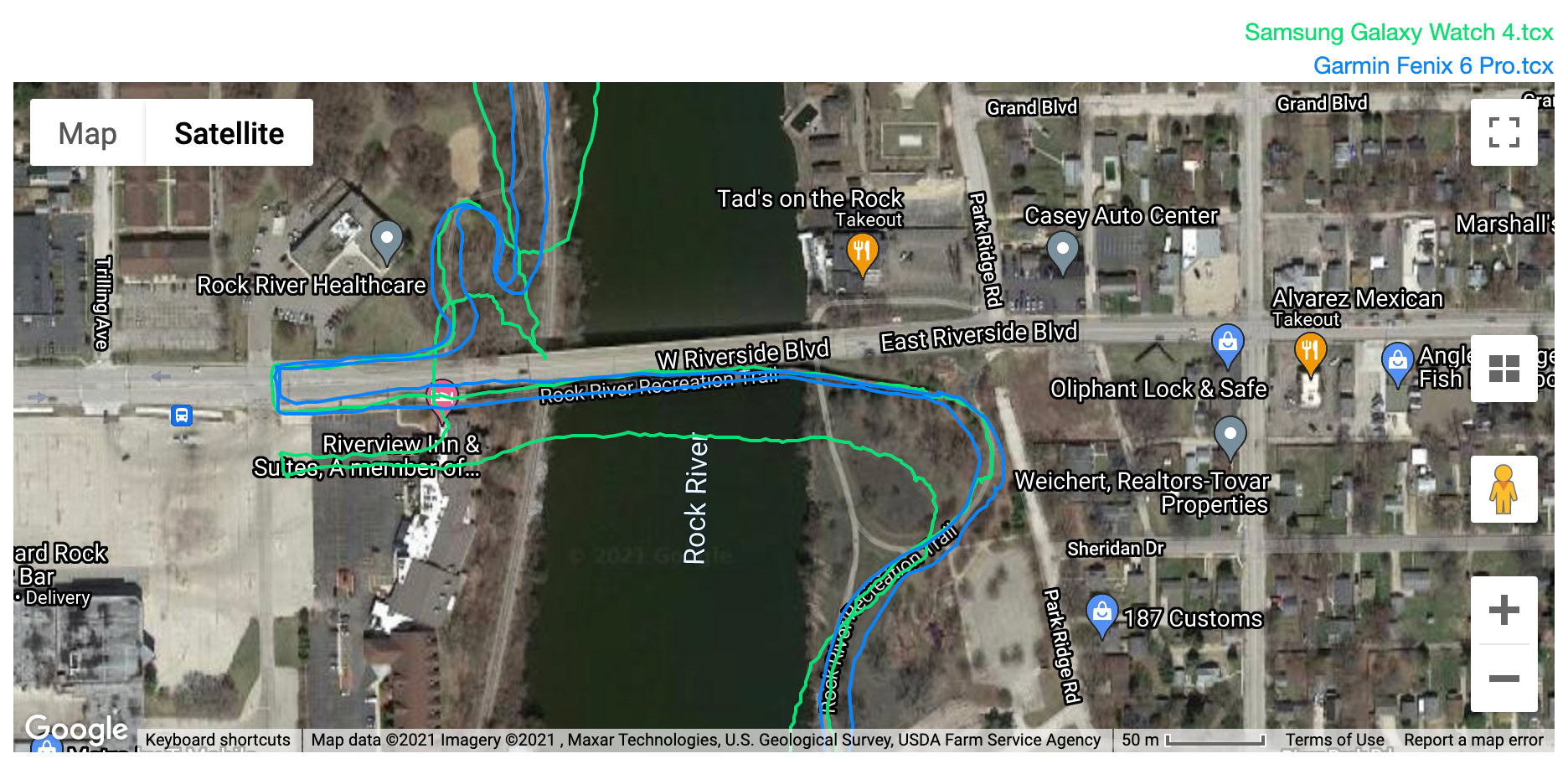
It didn’t get any better later in the run, where the Galaxy Watch, again, missed the bridge and had me running through the water. It never really recovered after that point. Now, the Fenix 6 Pro’s readings aren’t stellar here either, but you can see where Garmin’s device at least stuck to a general direction. Analyzing GPS data this closely isn’t the most important thing ever, but it does end up swaying overall numbers in the end. For this run, in particular, the Fenix 6 Pro reported exactly 15 miles whereas the Galaxy Watch only reported 14.5 miles. These types of errors can add up.
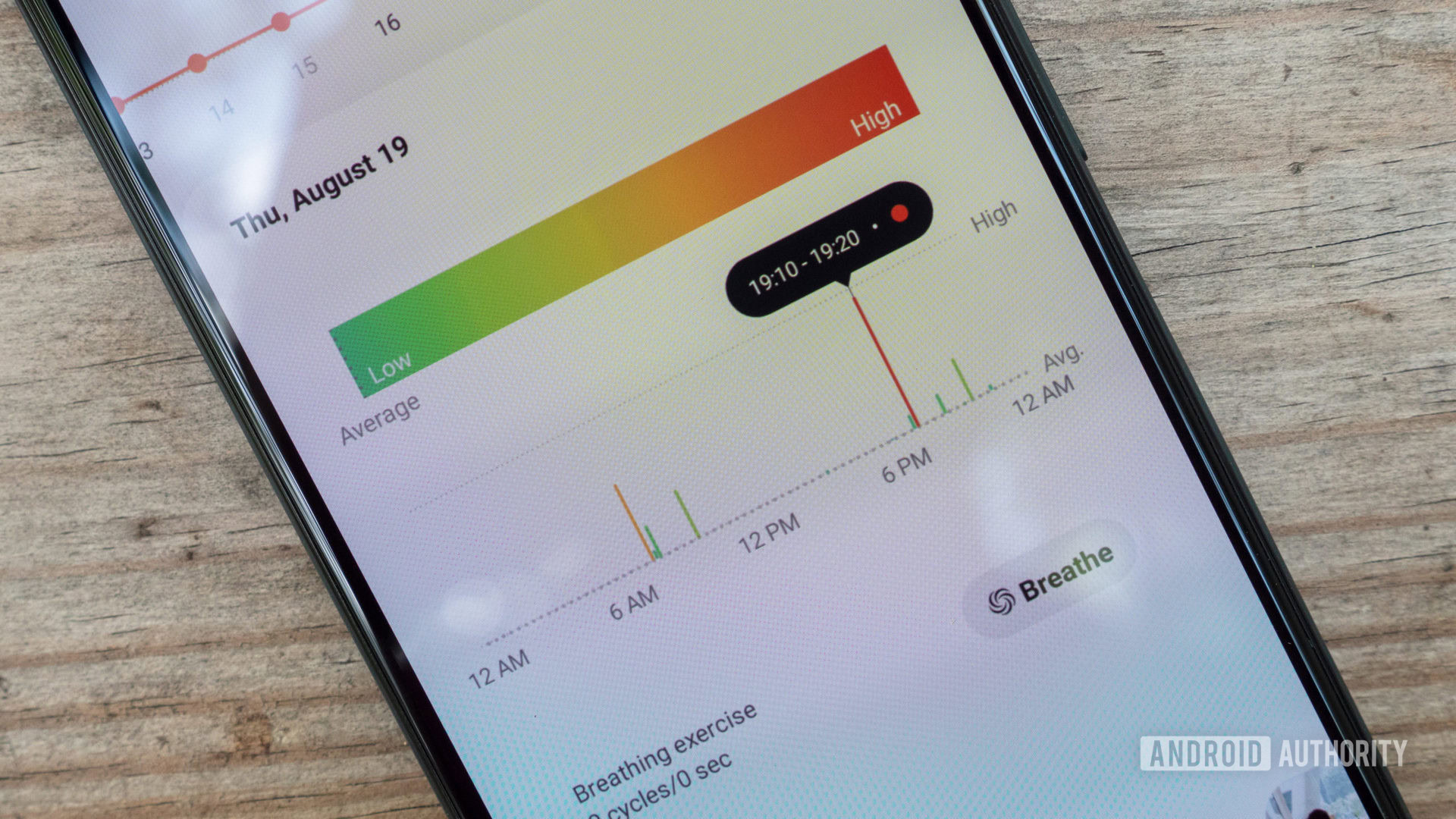
The Galaxy Watch 4 also uses a combination of heart rate and heart rate variability data to track your stress levels. It’s a nice gesture, though I haven’t found it to be too helpful in the Samsung Health app or on the watch itself. I’ve been, to put it lightly, very stressed lately, and the Galaxy Watch 4 tells me my stress levels are normal. When I have noticed a spike in my stress levels in Samsung Health, all I can see is how long I experienced that higher stress level and a rating of it between “average” and “high.” (Not the most scientific graph I’ve ever read.)
The app doesn’t offer any other details, like what my heart rate readings were at the time, if I was active, etc. To Samsung’s credit, it says your stress measurements “don’t necessarily reflect how you’re feeling.” You can, however, utilize the Galaxy Watch 4’s built-in breathing exercises if you’re feeling a little too tightly wound. Your watch can help you breathe with guided breathing exercises for up to five minutes if you need it.
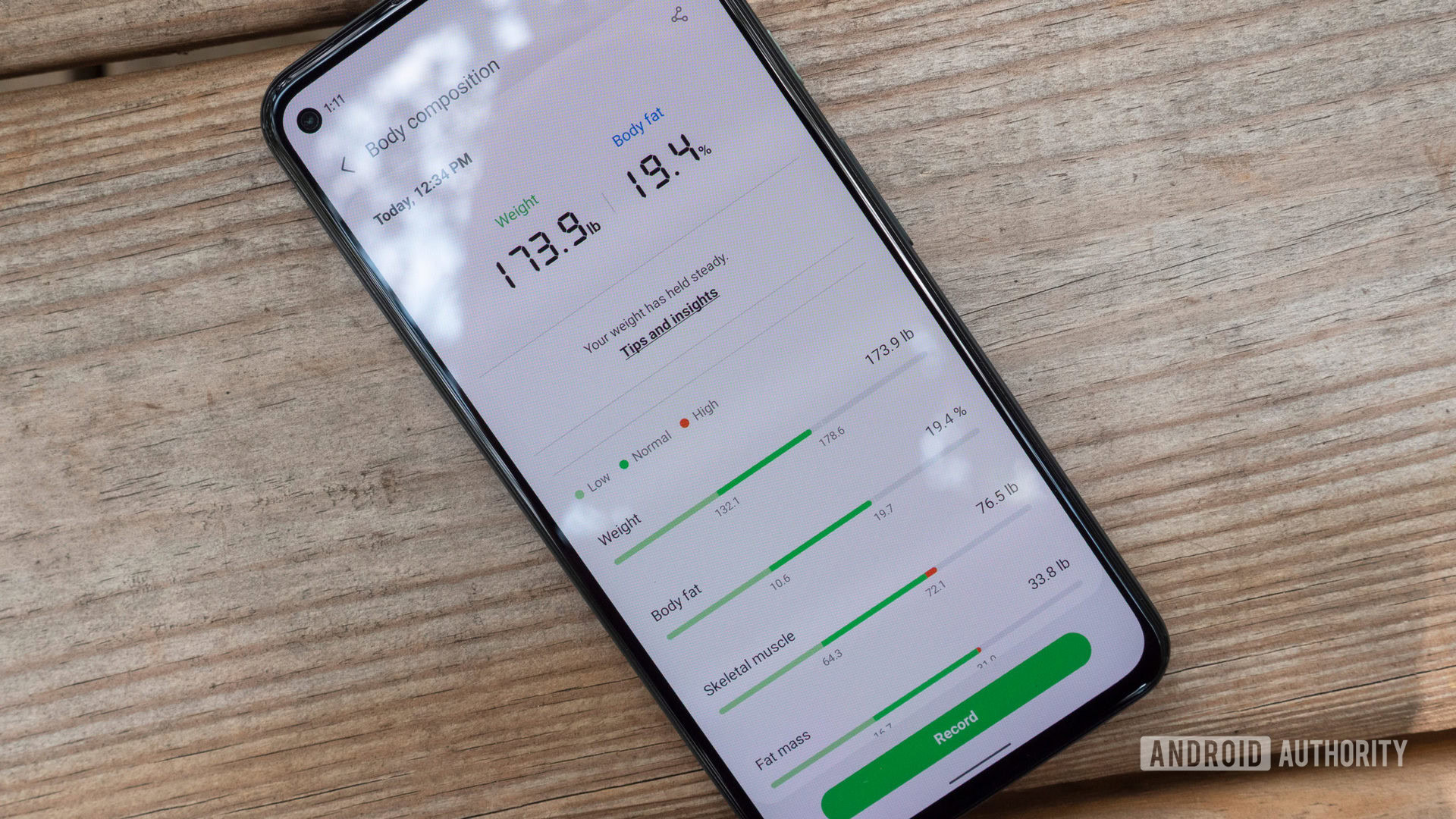
Next, onto the new bioelectrical impedance sensor. After placing your fingers on the two physical buttons for just 15 seconds, the Galaxy Watch 4 will attempt to determine your body composition metrics like skeletal muscle, basal metabolic rate (BMR), body mass index (BMI), water retention, and body fat percentage.
The Galaxy Watch 4's body composition metrics can be useful, but the data should be monitored over time.
I haven’t exactly been able to get a body fat analysis done at the doctor’s office recently, though I can compare some of the Galaxy Watch 4’s data with my Garmin Index S2 scale. The two devices lined up almost exactly with my BMI and water retention numbers. Garmin’s scale estimated I had 2% more body fat than the Galaxy Watch estimated, and Samsung overestimated my water retention percentage by about three pounds compared to the Index S2. Garmin also estimated my skeletal muscle was at ~74 lbs, while Samsung said I was closer to ~78 lbs.
For consumer devices, it’s difficult to put too much stock into the accuracy of the metrics, otherwise, you’ll constantly be wondering how they compare to your actual, doctor-certified numbers. The important thing is consistency. You want your Galaxy Watch 4, your smart scale, or other health and wellness device to give you consistent numbers so you can track trends over time. Luckily, Samsung Health provides trends for all of this data in daily, monthly, and yearly views. Seeing as how the results I’ve received from the Galaxy Watch 4 over the last week have been pretty consistent (give or take a few readings), I’d say the Galaxy Watch 4’s body composition metrics are a win overall.
Having a heart condition is not easy or fun, and visiting the doctor’s office and paying for expensive medical ECG tests can get old very quickly. The Galaxy Watch 4’s ECG feature is by no means a replacement for a medical test, and you should absolutely see a doctor if you sense there’s an issue, but the feature built into the Galaxy Watch 4 can be used in a pinch if you sense something is awry.
Recording an ECG takes 30 seconds and a moment of stillness. Once your recording is done, you can view your results in the Samsung Health Monitor app on your smartphone and export the results directly to your doctor if need be. Here’s what the Galaxy Watch 4’s recordings look like compared to other proven wrist-based ECGs from the Withings ScanWatch, Apple Watch Series 6, and Fitbit Sense.
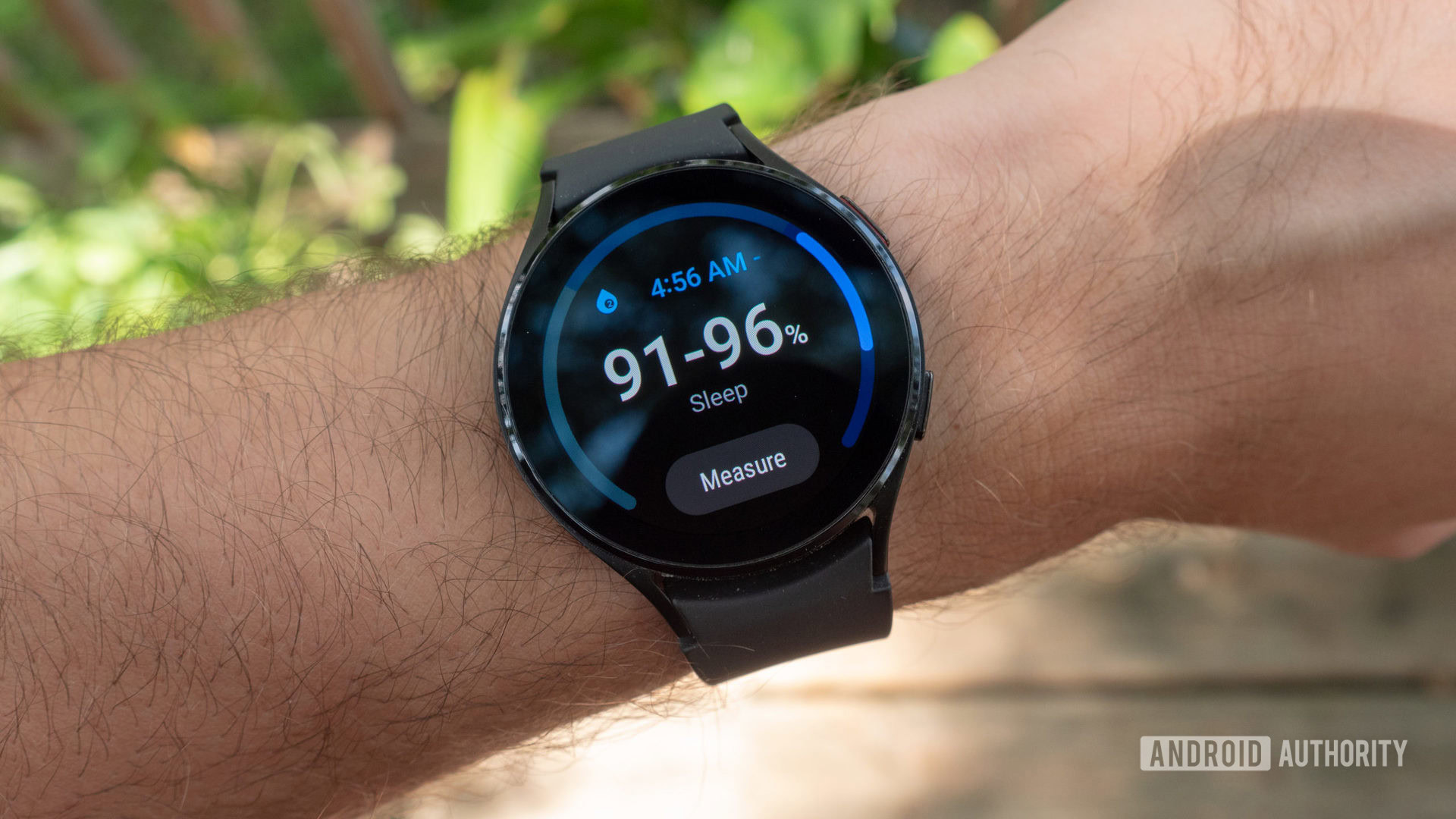
The Galaxy Watch 4 is also capable of recording your blood oxygen saturation (aka SpO2) on-demand throughout the day or overnight while you’re sleeping. On-demand readings with the Galaxy Watch 4 have lined up well with other devices used to record pulse oximetry. I tested it against the Withings ScanWatch, Apple Watch Series 6, Garmin Fenix 6 Pro, and my trusty fingertip monitor, and all came back between 95-99%. I rarely dip below 95%, though, so these results were expected.
At night, the Galaxy Watch 4 collects blood oxygen data in one-minute increments while you’re sleeping. Notably, many other wrist-worn wearables only record SpO2 readings every 30 minutes or so. The Samsung Galaxy Watch 4 also tracks your sleep stages (light, deep, REM), time awake, SpO2 (as noted above), and even your snoring as long as you have a paired Samsung phone. For the record, I’m not a snorer, so I never received any snoring data. After this review was published, Samsung introduced a new gamified sleep tracking experience in February 2022, which assigns a “sleep animal” based on sleeping habits. In reality, this system doesn’t really improve sleep, but Samsung lumps in coaching, achievements, and more based on this data. It’s all in a bid to encourage healthier sleep.
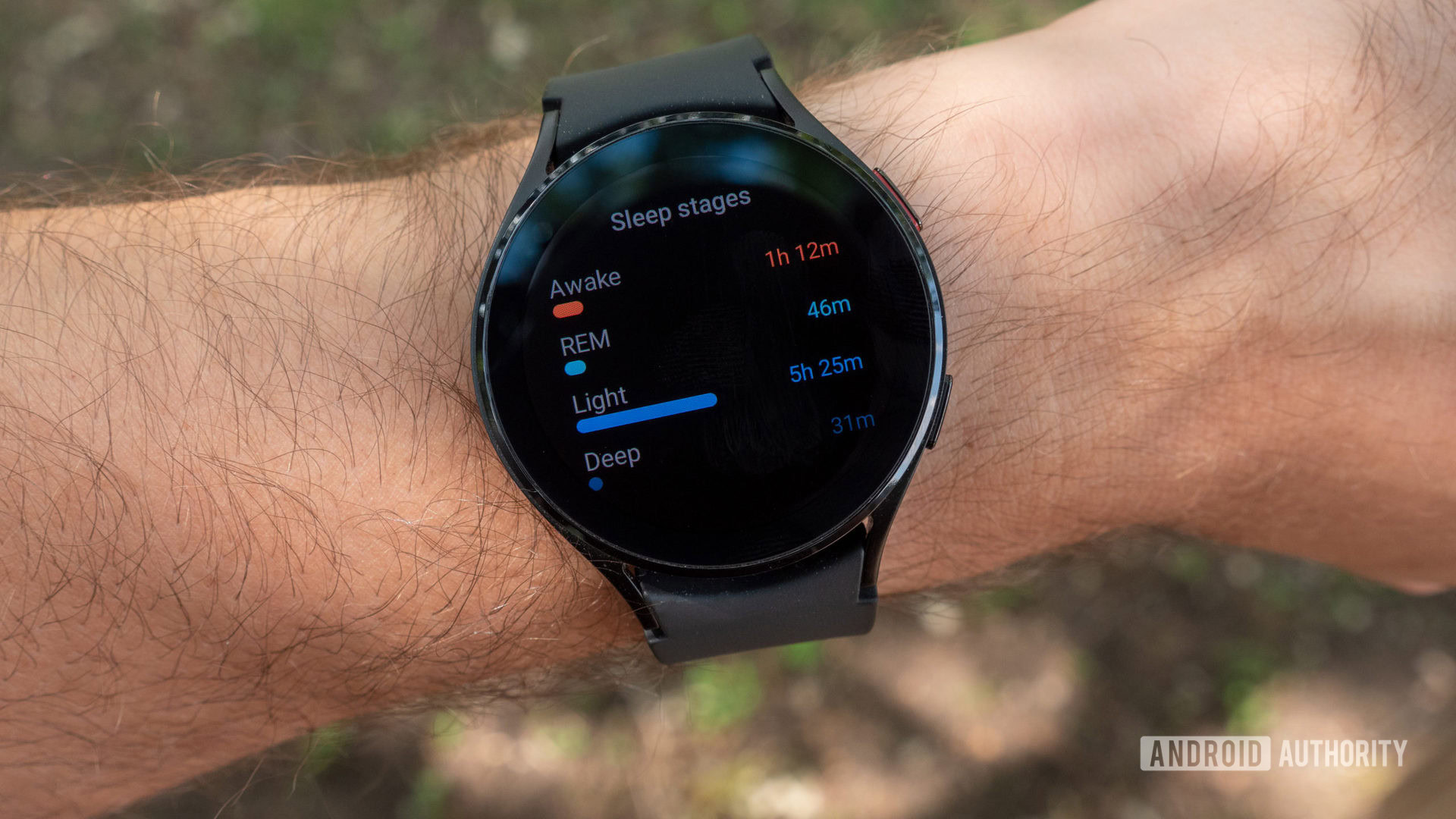
I used the Fitbit Sense as my go-to sleep tracker for this comparison because I’ve found it provides the most useful, accurate data from a wrist-based device. On most nights, the Galaxy Watch 4 and Fitbit Sense lined up their sleep stages well. Both caught random mid-night bathroom breaks, as well as major REM and light stages.
There’s a small difference between the way the two devices handle overall sleep data, which can affect your sleep score. On one night, the Sense reported seven hours and 45 minutes of sleep and 1 hour and 8 minutes of being awake. The Galaxy Watch 4 reported seven hours and 23 minutes of sleep and one hour and 43 minutes of being awake. The Galaxy Watch, though, added up all of this data and reported a total of nine hours and seven minutes of total sleep time, even though I definitely wasn’t sleeping for almost two hours that night.
This made my sleep score drop down to 50 (out of 100, which isn’t good) because getting more than nine hours of sleep can negatively affect your sleep score. Luckily, some simple tweaking in the Samsung Health app should be able to fix this issue. Still, keep this in mind if you’re putting stock into Samsung’s nightly sleep scores.
Wear OS: Lots of Samsung, lots of changes, and lots of promises
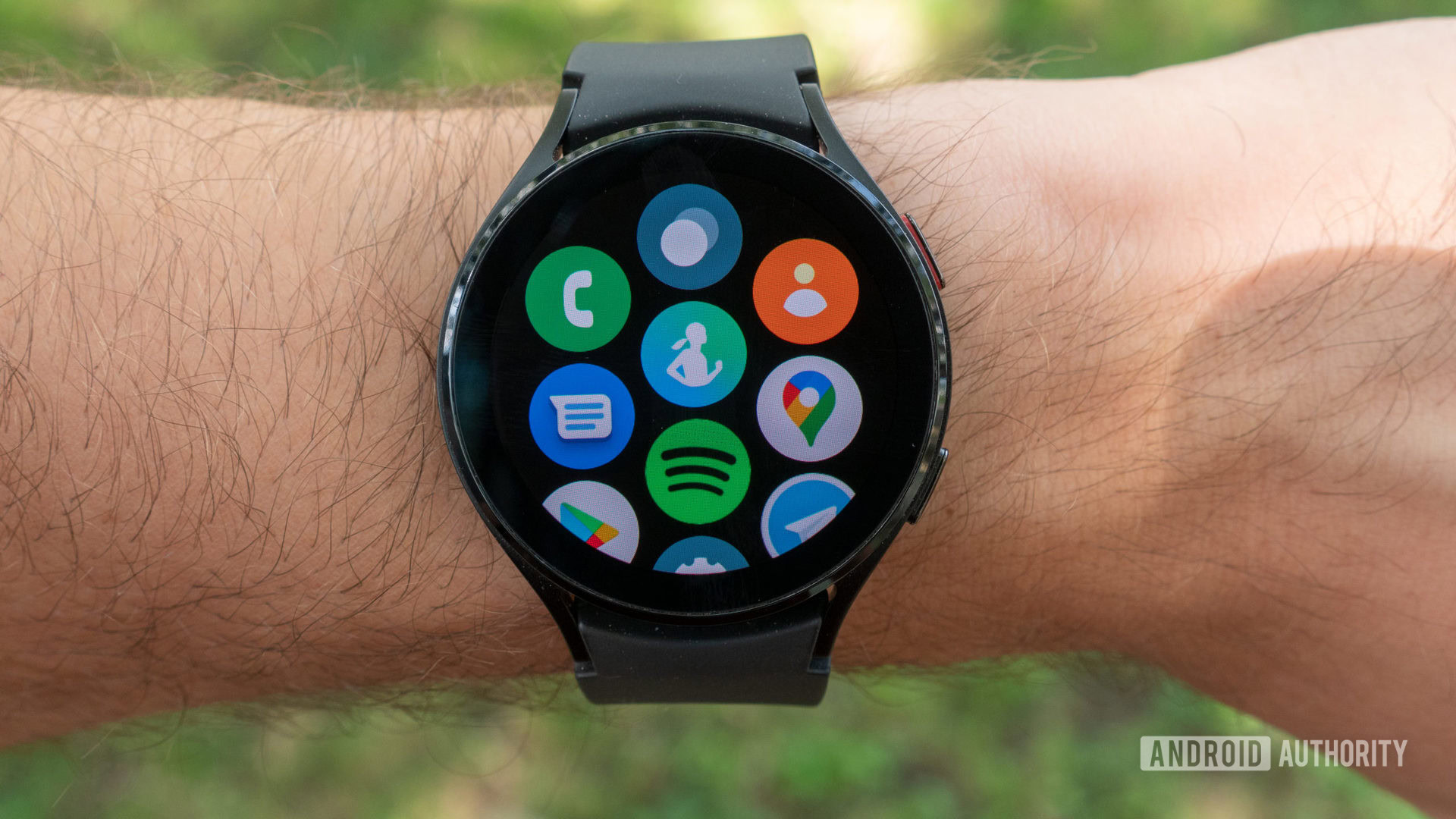
The Samsung Galaxy Watch 4 was, of course, the first smartwatch to run on Google and Samsung’s co-developed Wear OS 3 platform. But unless you’re one of us and care about the underlying software platform powering the overall experience, you might not even notice things have changed much from the last Galaxy Watch. Put more simply, this feels like a Galaxy Watch with Samsung software, only with a few familiar Wear OS elements peppered around. Thanks to Google’s hands-off approach with Wear OS you’ll see largely different software experiences depending on the smartwatch maker. Google has also since launched the Pixel Watch, which gave us a better idea of Wear OS on a Google device.
Wear OS 3 with Samsung’s One UI Watch overlay is injected with Samsung apps, services, and customizations. Google Fit is no longer the default fitness app; it’s Samsung Health. Samsung Pay, not Google Pay, is the contactless payment system that ships by default. You can download Google Pay from the Play Store, however. Samsung’s app partnerships have also made their way to the new platform — Microsoft Outlook is available on the Galaxy Watch 4 out of the box, just like it is on Samsung phones. Although missing at launch, Google Assistant rolled out to the Galaxy Watch 4 series in May 2022. It adds welcome smart utility but its performance isn’t flawless. Additionally, you may face a few battery consumption problems with Assistant enabled. The watch is also compatible with a number of third-party fitness apps including the new Peloton app for Wear OS, which launched in early April 2023.
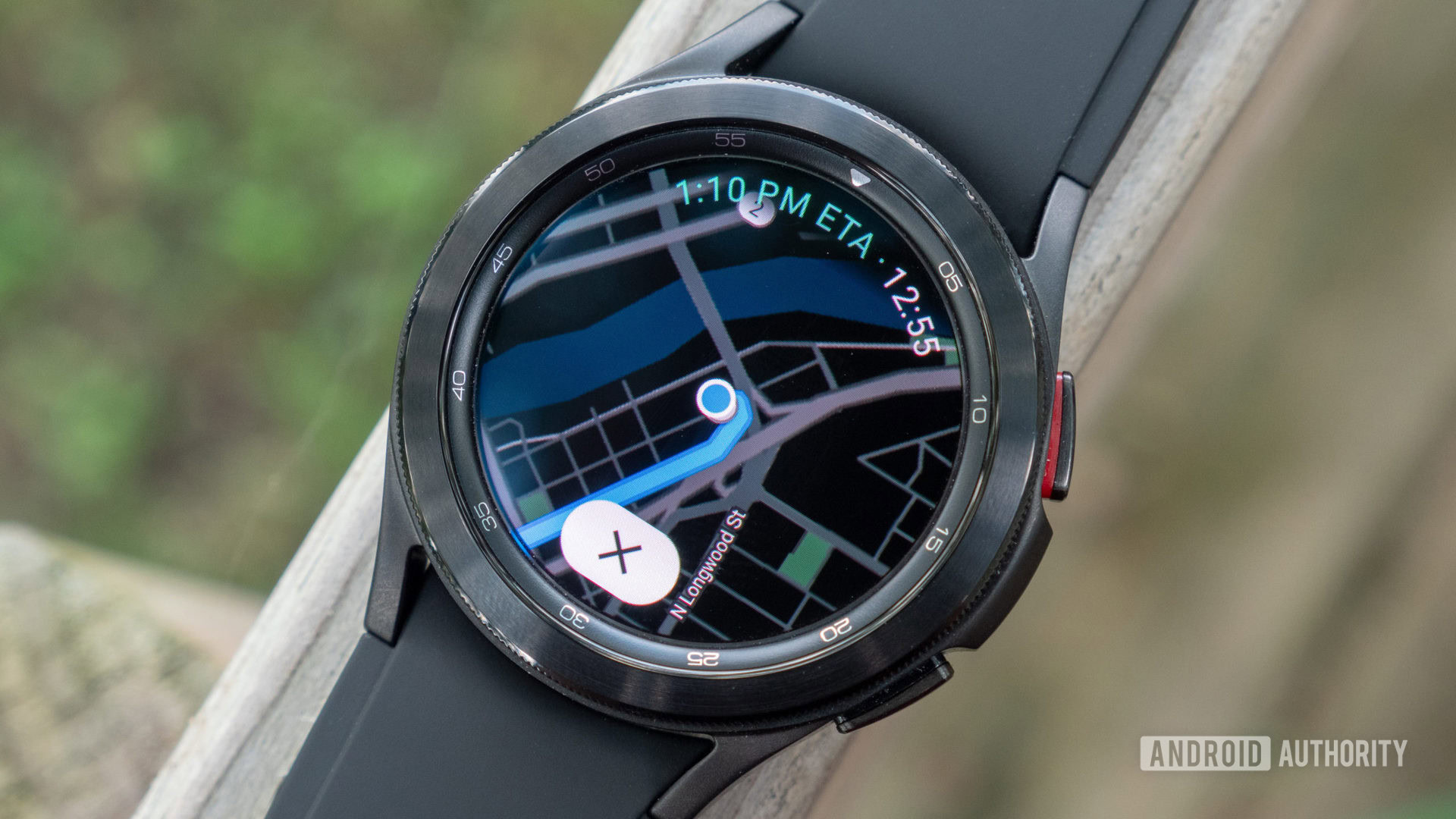
Since the Galaxy Watch 4 now has access to the Google Play Store, that means you have access to more Google apps. The new-and-improved Google Maps is here and works quite well, even though it’s as big of a battery drainer as usual. YouTube Music also rolled out to Wear OS 3, complete with offline downloads. Spotify support made its wat to the Galaxy Watch 4 after launch as well . The watch also supports uploading local music files. Luckily, Samsung makes it easy enough to transfer music to the watch through the Galaxy Wearable app. Google Wallet and Google Home are also now available on the Galaxy Watch 4, bringing Google’s mobile payments and smart home controls to the Samsung wearable.
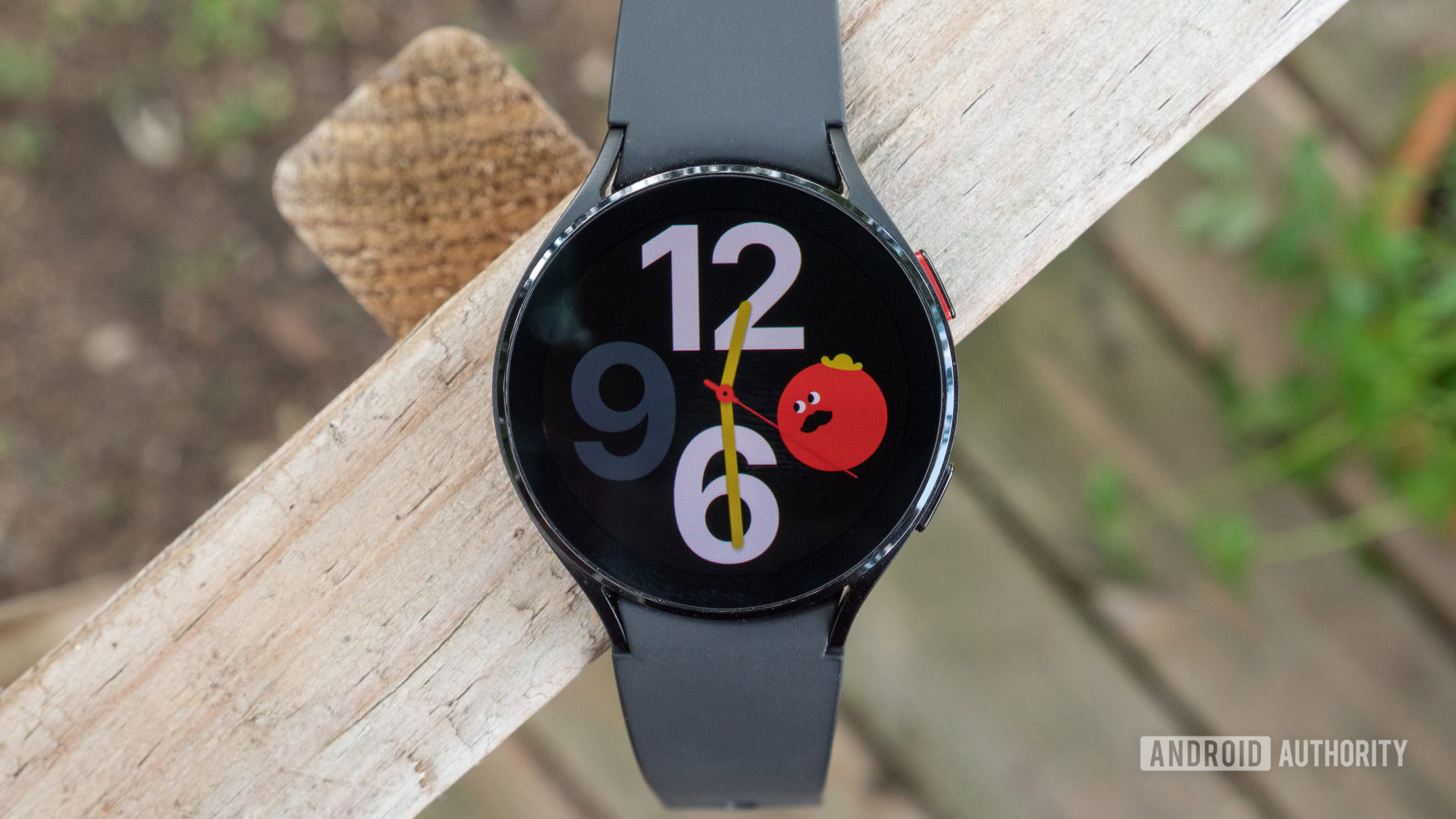
I want to be clear: the Galaxy Watch 4’s software is good. I’ve run into no major bugs or performance issues throughout my time with it, which is really saying something for a mostly all-new platform. I also like the user interface. I find it far easier to navigate around than previous versions of Wear OS. You swipe down on the screen for quick settings, swipe right for notifications, left for Tiles (aka widgets), and up for the all-apps screen. Say what you will about Google copping Apple’s bubbly all-apps page, but it works. Finding and launching apps is easy. Speaking of which, you can double-tap the top-right physical button to launch your most recently used app, similar to how it works on Android.
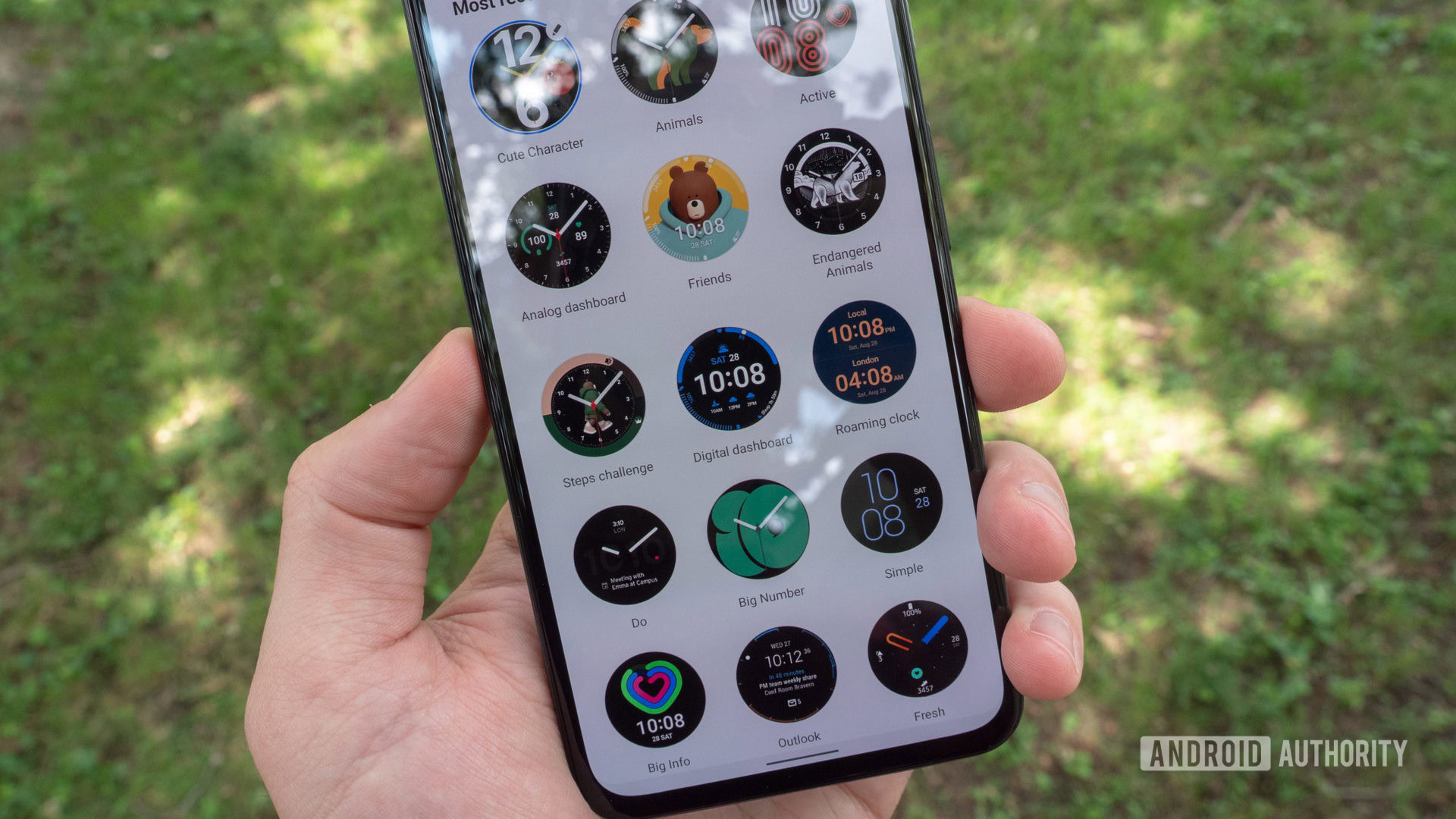
There are plenty of native watch faces to play around with on the Galaxy Watch 4. Since launch, Samsung has brought a host of additional faces to the device in in multiple software updates too. Some are simple and sleek, some are informative, some are borrowed from the Galaxy Watch 5, others are bright, and a few are just… bananas. One analog watch face replaces the “three” with some type of fruit or vegetable with a hat, which bounces around when you wake up the watch face. I can never tell the time properly with this watch face, but I don’t even care. It just brings me joy. You can also hit the Google Play Store for even more Wear OS watch faces from third-party developers.
As a platform, I think Wear OS 3 shows promise, and after two years, its off to a surprisingly great start. Google has Samsung — one of the biggest names in the industry — backing its new-and-improved platform. Even so, I hate to be the guy that brings up Google’s past, but I’m going to bring up Google’s past. Google has traditionally done a poor job of keeping previous versions of Wear OS updated. It announced its scarce software updates in device forums, for instance, and let major bugs go unfixed for months.
Google's commitment to updates will make or break Wear OS 3's success over time.
However, Samsung is taking full responsibility for updating its watch. The company is hopeful for the new platform’s longevity and said it will continue to update core One UI Watch apps and fix bugs as they pop up. The company confirmed in February 2022 that the Galaxy Watch 4 will receive software support for “up to four years.” During the life of the Galaxy Watch 4 to date, Samsung has issued regular patches that have either introduced new features, smoothed out existing problems, or addressed security concerns. We can only applaud it for its efforts so far. We just need to hope Google is here to play ball this time around and not let things slip by as they used to.
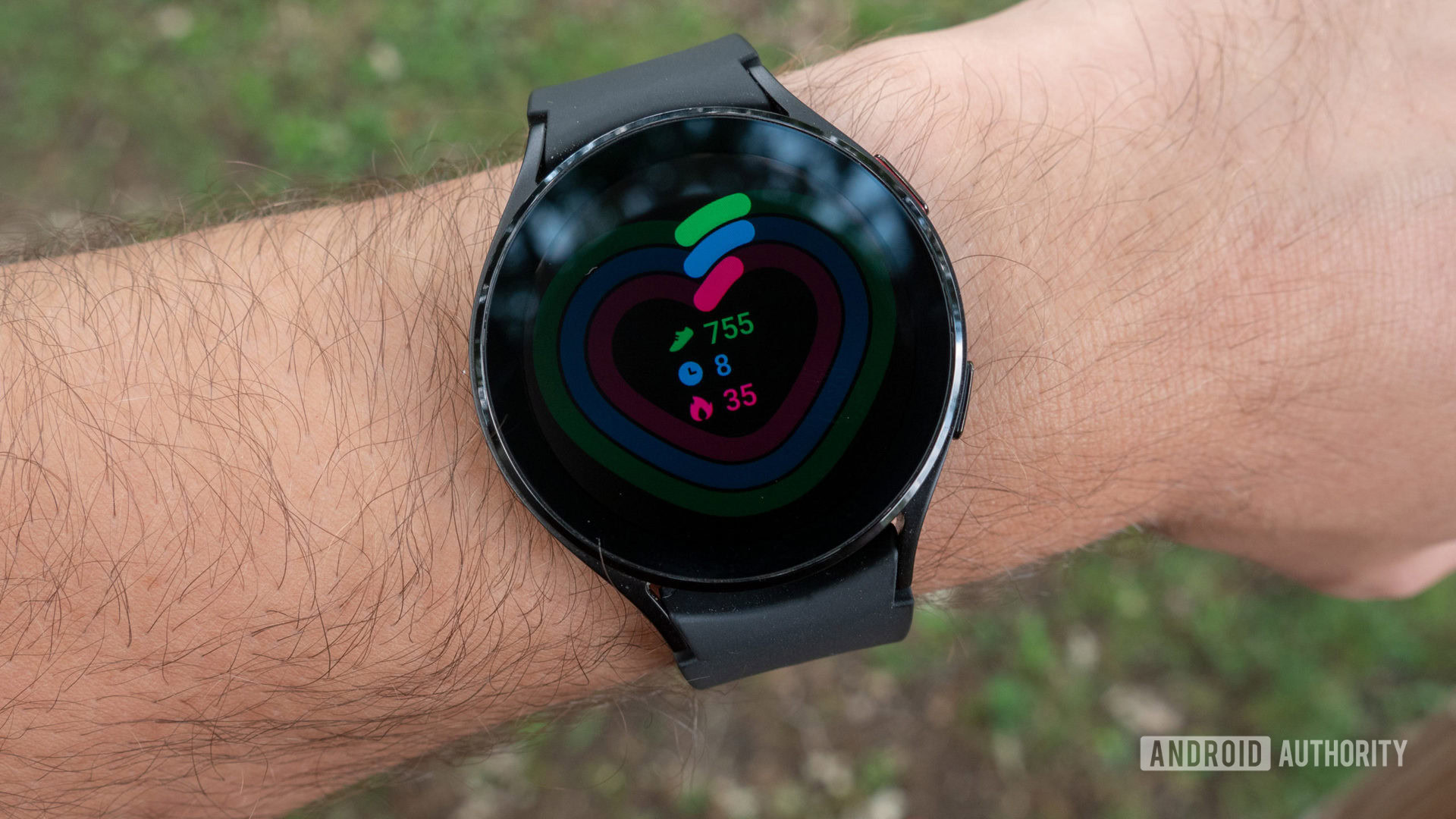
A few other software tidbits worth sharing:
- A different onboarding experience: If you’ve ever set up a Wear OS device, the process is much more like setting up a Samsung smartwatch. You don’t use the Wear OS smartphone app at all. Instead, you download Samsung’s Galaxy Wearable app and do everything from there, from the initial setup phase to changing watch faces. Also, on non-Samsung phones, you still need to download extra background apps like Samsung Accessory Service and Galaxy Watch 4 plug-in.
- Setup niceties: During the setup process, the Galaxy Watch 4 will automatically install apps you have on your phone so you don’t need to search for them through the Play Store as you did before. The watch also recognizes phone settings like do not disturb and blocked callers.
- No more iPhone support: Unlike previous Wear OS versions, Wear OS 3 devices do not pair with iPhones. We asked Google if iPhone support would be added in the future. The company said it has, “Nothing to share regarding future device roadmap and plans.”
Samsung Galaxy Watch 4 specs
| Samsung Galaxy Watch 4 | Samsung Galaxy Watch 4 Classic | |
|---|---|---|
Display | Samsung Galaxy Watch 4 44mm: 1.36-inch Super AMOLED 450 x 450 resolution 330ppi Corning Gorilla Glass with DX+ 40mm: 1.19-inch Super AMOLED 396 x 396 resolution 330ppi Corning Gorilla Glass with DX+ | Samsung Galaxy Watch 4 Classic 46mm: 1.36-inch Super AMOLED 450 x 450 resolution 330ppi Corning Gorilla Glass with DX 42mm: 1.19-inch Super AMOLED 396 x 396 resolution 330ppi Corning Gorilla Glass with DX |
Dimensions and weight | Samsung Galaxy Watch 4 44mm: 44.4 x 43.3 x 9.8mm 30.3g 40mm: 40.4 x 39.3 x 9.8mm 25.9g Compatible with 20mm straps | Samsung Galaxy Watch 4 Classic 46mm: 45.5 x 45.5 x 11mm 52g 42mm: 41.5 x 41.5 x 11.2mm 46.5g Compatible with 20mm straps |
Colors and materials | Samsung Galaxy Watch 4 Aluminum case Black, Silver, Green (44mm only), Pink Gold (40mm only) | Samsung Galaxy Watch 4 Classic Stainless steel case Black, Silver |
Battery | Samsung Galaxy Watch 4 44mm: 361mAh 40mm: 247mAh WPC-based wireless charging | Samsung Galaxy Watch 4 Classic 46mm: 361mAh 42mm: 247mAh WPC-based wireless charging |
Processor | Samsung Galaxy Watch 4 5nm Samsung Exynos W920 Dual-core 1.18GHz | Samsung Galaxy Watch 4 Classic 5nm Samsung Exynos W920 Dual-core 1.18GHz |
RAM | Samsung Galaxy Watch 4 1.5GB | Samsung Galaxy Watch 4 Classic 1.5GB |
Storage | Samsung Galaxy Watch 4 16GB | Samsung Galaxy Watch 4 Classic 16GB |
Connectivity | Samsung Galaxy Watch 4 LTE (available in select models) Bluetooth 5.0 Wi-Fi 802.11 a/b/g/n 2.4+5GHz NFC GPS/GLONASS/Beidou, Galileo | Samsung Galaxy Watch 4 Classic LTE (available in select models) Bluetooth 5.0 Wi-Fi 802.11 a/b/g/n 2.4+5GHz NFC GPS/GLONASS/Beidou, Galileo |
Sensors | Samsung Galaxy Watch 4 Accelerometer Barometer Gyroscope Geomagnetic sensor Ambient light sensor Samsung BioActive sensor: optical heart rate (PPG), electrocardiogram (ECG), bioelectrical impedance analysis sensor (BIA) | Samsung Galaxy Watch 4 Classic Accelerometer Barometer Gyroscope Geomagnetic sensor Ambient light sensor Samsung BioActive sensor: optical heart rate (PPG), electrocardiogram (ECG), bioelectrical impedance analysis sensor (BIA) |
Durability | Samsung Galaxy Watch 4 5ATM + IP68 MIL-STD-810G | Samsung Galaxy Watch 4 Classic 5ATM + IP68 MIL-STD-810G |
Software | Samsung Galaxy Watch 4 Wear OS Samsung One UI Watch | Samsung Galaxy Watch 4 Classic Wear OS Samsung One UI Watch |
Compatibility | Samsung Galaxy Watch 4 Android | Samsung Galaxy Watch 4 Classic Android |
Value and competition


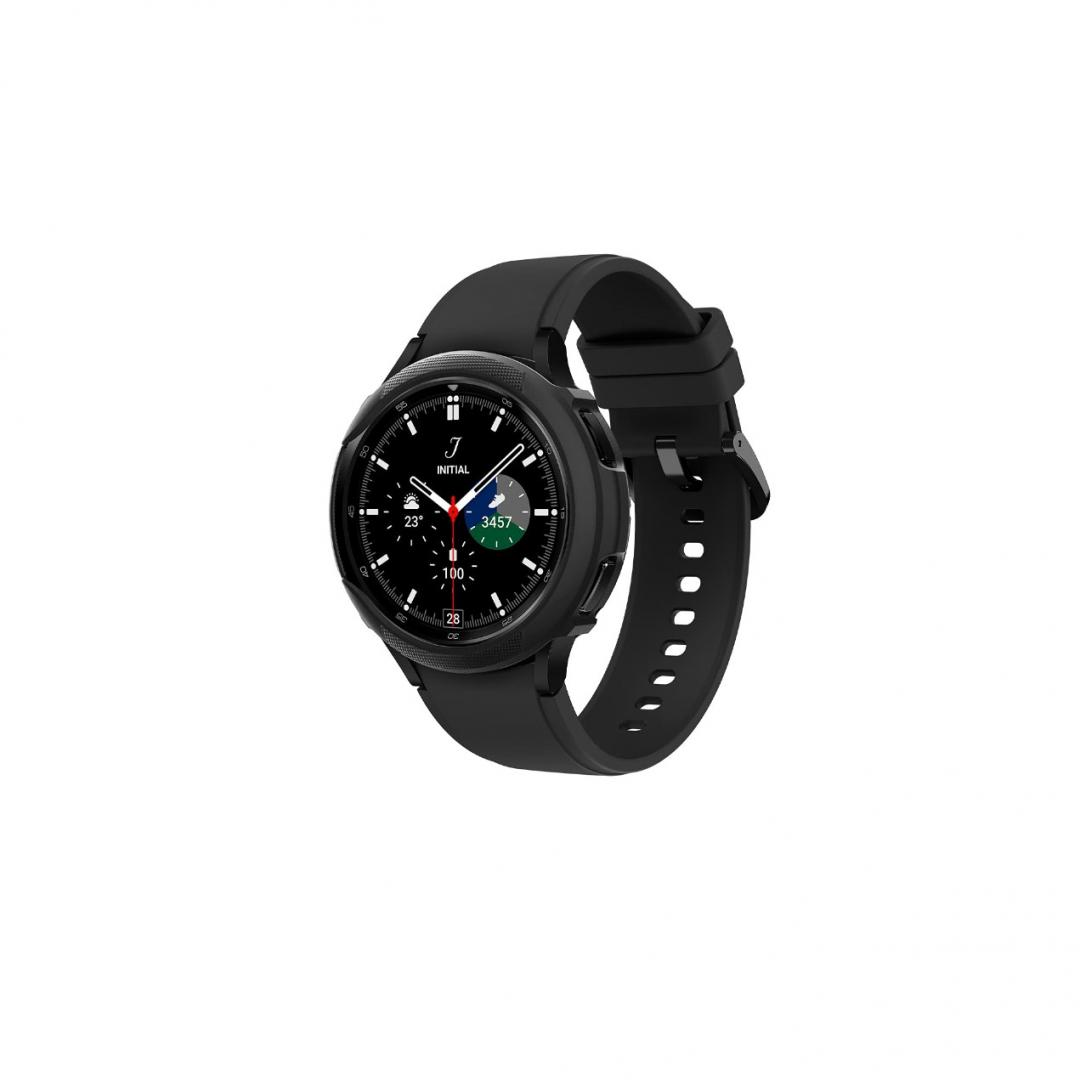

In the Wear OS ecosystem, the Samsung Galaxy Watch 4 is no longer your best or only option. The Galaxy Watch 5 ($279) is a more polished jumping-off point for first-time buyers, while the Pixel Watch ($349) is a compelling Fitbit-packing alternative made by Google. Mobvoi’s TicWatch Pro 3 Ultra ($299 at Amazon) and TicWatch E3 ($199 at Amazon) are both due Wear OS 3 upgrades, however, we recommend skipping these watches until that upgrade date arrives. The Fossil Gen 6 ($188 at Amazon) is another solid Wear OS smartwatch that received a Wear OS upgrade. It’s a little more stylish than the Galaxy Watch 4 but is lacking in the fitness tracking stakes.
Our pick for the best fitness smartwatch on Android is the Garmin Venu 2 Plus ($449 at Amazon). Garmin’s latest smartwatch doesn’t have as many smart features as the Galaxy Watch 4 line, but its well-designed interface, an abundance of sports-tracking features, and great battery life make it one of the best picks of available.
The Fitbit Versa 3 ($158 at Amazon) is a cheaper alternative to the Galaxy Watch 4 that comes with plenty of fitness-tracking features, fantastic sleep tracking, and even Google Assistant and Amazon Alexa support. Though the line received a new generation, we weren’t crazy about the Versa 4 during our review period.
If you’re reading this on your iPhone and were hoping for Android support with Wear OS 3, the Apple Watch is (obviously) worth checking out. It’s our favorite smartwatch hands down (and that’s saying something coming from an Android-focused website), and can regularly be found on sale. The Apple Watch Series 8 ($399) is the better option for health tracking, while the Apple Watch SE 2 ($249) is a nice budget pick.
Samsung Galaxy Watch 4 review: The verdict
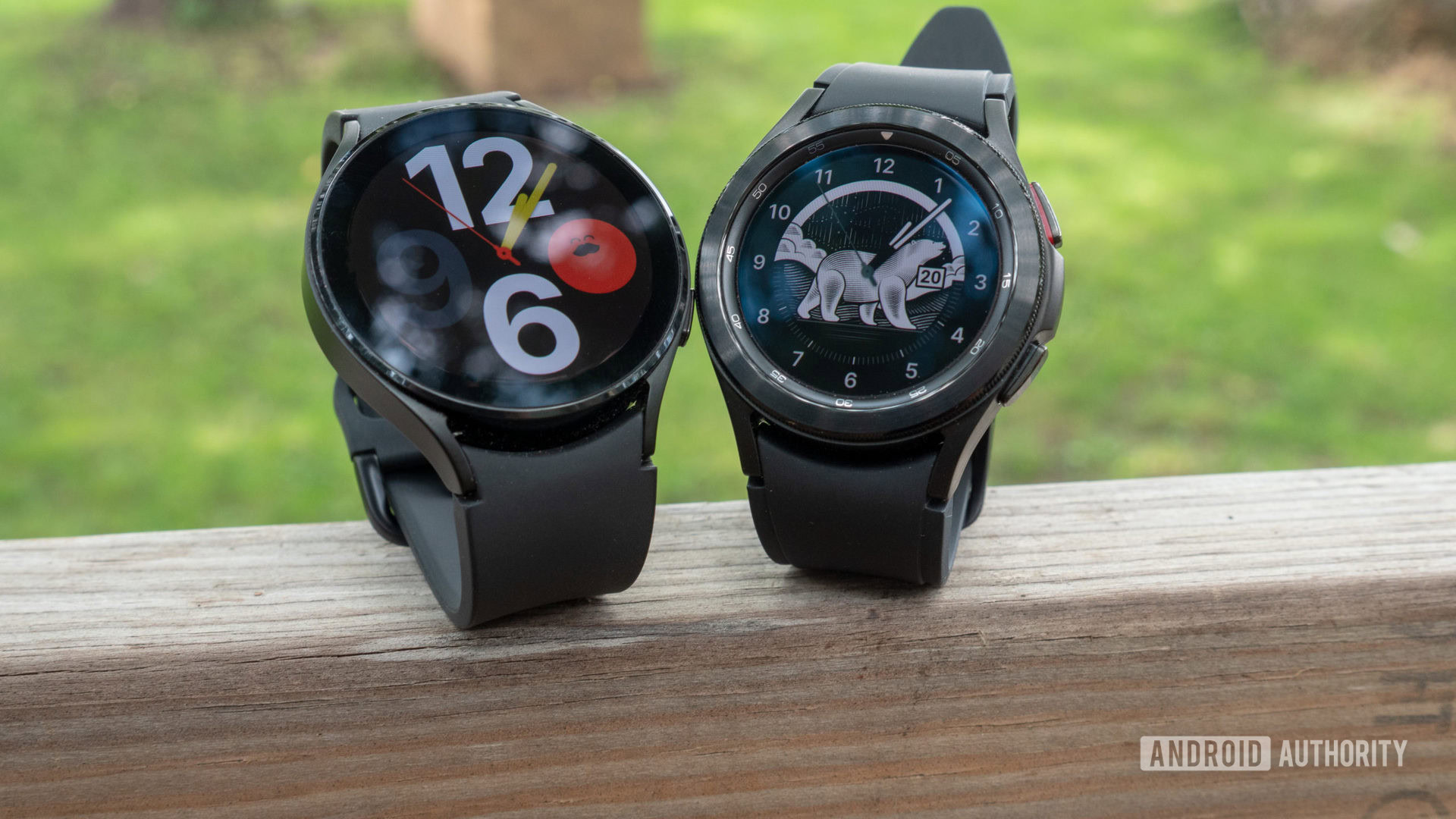
The Samsung Galaxy Watch 4 and Galaxy Watch 4 Classic are good smartwatches. All of the smart features work well, the fitness features are abundant and improved, and both devices can be customized to your particular size and style. The software, even with Samsung’s One UI Watch overlay, is all-around better and easier to use than Wear OS 2 and Samsung’s older Tizen software. Plus, the benefit of leaning on Google for its larger developer ecosystem will only make the Galaxy Watch 4 series even more robust over time.
The Samsung Galaxy Watch 4 is a fantastic smartwatch that I wouldn't hesitate to recommend to any Android user.
That is, as long as Google and Samsung keep the momentum going over time. Maybe I’m making a bigger deal out of Google’s bad update track record than I should be. Maybe the Google-Samsung partnership for Wear OS 3 will flourish. For now, the Samsung Galaxy Watch 4 and Classic are two fantastic smartwatches I wouldn’t hesitate to recommend to any Android user. That is, as long as that user doesn’t need the latest and greatest. For that you’ll need to spring for a Galaxy Watch 5 series device.
Top Samsung Galaxy Watch 4 questions and answers
The Galaxy Watch 4 remains a solid Wear OS smartwatch. If you can find it at the right price, it’s an excellent feature-packed option.
If you own an LTE version of the watch and have a mobile plan, you can place calls from the Galaxy Watch 4. Non-LTE models can accept and reject calls to the tethered phone.
Yes, there is an LTE version of the Galaxy Watch 4 Classic.
They’re essentially the same devices, however, the Galaxy Watch 4 Classic is available in 42mm and 46mm dial sizes. The dial also features a physical rotating bezel.
To intiate an update from your watch, head over to Settings > Software update. If an update is available, install it. If you do not see an update available, it may not have yet reached your region. For troubleshooting tips, see our complete guide to common Galaxy Watch 4 problems and solutions.